Below are examples of exceptional results for Documents, Books, and Maps auctioned by Case Antiques, Inc. The sold price includes the Buyer’s Premium. If you have items like these in an estate, a private collection, or a museum, and would like to sell them, visit our selling page to learn more about consigning. We appreciate your interest!
If you are interested in consigning items of this quality for future auctions, please contact us at info@caseantiques.com.
(Note: Prices realized include a buyer's premium.)
| Thumbnail | Title | Description | Realized Price |
|---|---|---|---|
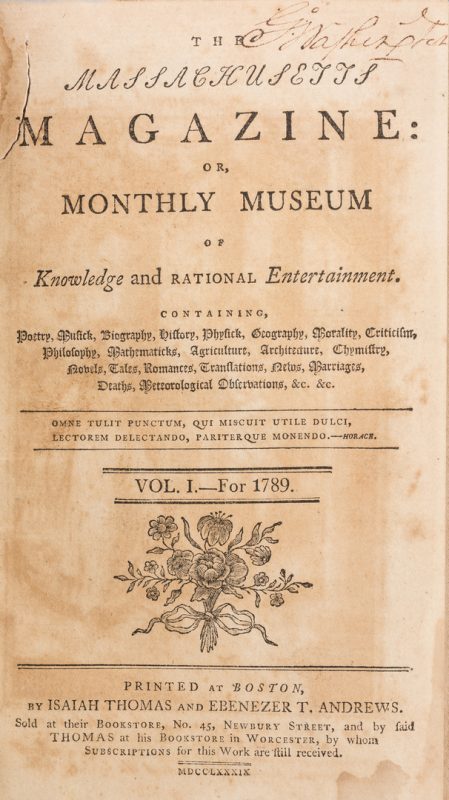 |
George Washington Signed Book w/ Bookplate |  GEORGE WASHINGTON (1732-1799). Washington was Founding Father, Commander-in-Chief of colonial forces during the American Revolutionary War and the first President of the United States of America. A volume signed by George Washington on the top of the title page. The book a bound copy of the first five issues of Volume One of “The Massachusetts Magazine: or Monthly Museum of Knowledge and Rational Entertainment”, published by Isaiah Thomas and Ebenezer T. Andrews of Boston in 1789. The inside front cover has his armorial bookplate and this book was once in his Mount Vernon library. The front endpaper has an inscription reading “Lewis Minor Coleman, Jr./1911/ Presented by his grandmother M.A.MC. from the library of his great-great-grandfather Chief Justice John Marshall”. The Massachusetts Magazine, founded in 1789 and published until 1796 by the famous printer Isaiah Thomas, advertised on its title page that it contains “poetry, music, biography, history, physics, geography, morality, criticism, philosophy, mathematics, agriculture, architecture, chemistry, novels, tales, romances, translations, news, marriages, deaths, eteorological observations, etc. etc.”. It was founded at the same time as the nation to act as “a kind of thermometer, by which the genius, taste, literature, history, politics, arts, manners, amusements and improvements of the age and nation, may be ascertained”. This particular book is important for Washington since it covers the events of 1789 that included his inauguration as the country’s first President. For example, page 314 is entitled “Papers relative to the President of the United States” and includes a printing of his Inaugural Address that starts with “Among the vicissitudes incident to life, no event could have filled me with greater anxieties than that of which the notification was transmitted by your order…”. It is then followed by “The Address of the Senate to the President of the United States In Answer to his Speech to Both Houses of Congress”. On page 286 is a passage entitled “Memoirs of General Washington”. In other words, Washington kept this book since it was a “clippings file” of his first year as President. An outstanding Washington signed book with a great association year and terrific content. Front endpaper with inscription reading: Lewis Minor Coleman, Jr./1911/ Presented by his grandmother M.A.M.C. (Mary Ambler Marshall Coleman) from the library of his great-great-grandfather Chief Justice John Marshall. Provenance: The Estate of Charles Boyd Coleman, Jr., Chattanooga, TN, by descent from Lewis Minor Coleman, Jr., son of CSA Lt. Colonel Lewis Minor Coleman and Mary Ambler Marshall, daughter of James K. Marshall and granddaughter of John Marshall (1755-1835). Lewis M. Coleman Jr. was also related to the family of Henry Dearborn by his marriage to Julia Wingate Boyd, daughter of Annette Maria Dearborn Boyd, who was the daughter of Greenleaf Dearborn (1786-1846) and great granddaughter of Henry Dearborn (1751-1829) on her mother’s side. Note: John Marshall was the fourth Chief Justice of the United States, serving for thirty-five years. He oversaw landmark decisions such as Marbury v. Madison, McCulloch v. Maryland, Gibbons v. Ogden and the Dartmouth College case. His lifelong friendship with George Washington developed during their Revolutionary War service including the winter at Valley Forge and the battles at Brandywine and Monmouth; he went on to write one of the early biographies of America’s first president (see related lots, #263, 264). Description courtesy of Stuart Lutz Historic Documents, Inc. CONDITION: This volume has been rebacked and rebound in leather with new endpapers before 1911 and is in good condition. It appears that the original front cover has been incorporated into the binding and shows some wear. The bookplate has been preserved and is in good condition. The front cover is scuffed. There is a slight tear to the title page nowhere near the dark Washington autograph, and there is toning and spotting to the interior pages. [See more photos →] |
$138,000.00 |
 |
10 vol. Audubon Octavo Birds of America, Quadruped |  Exceptional complete set of Audubon Octavo Birds and Quadrupeds (total 10 volumes). Includes the 7 volume – The Birds of America, from Drawings made in the United States and their Territories. New York: V. G. Audubon, Roe Lockwood & Son, 1860. The set also includes the 3 volume – The Quadrupeds of North America. New York: V. G. Audubon, 1856. This complete 10 volume set contains a total of 655 hand colored lithographed plates – 500 plates for the Birds of America volumes, 155 plates for the Quadrupeds of North America. Bird plate size 10 3/8″ x 6 5/8″. Quadruped plate size 10 1/2″ x 6 5/8″. Each volume with the inscription, “From Library of Hardy Bryan Aug 1860” and the later inscription, “To Hardy Bryan Branner from His Mother Magnolia Bryan Branner May 2nd 1897 with love”. Hardy Bryan Branner was mayor of Knoxville in 1880, a graduate under Robert E. Lee at Washington College, and co-founder of Standard Knitting Mills. He is buried in Old Gray Cemetery, Knoxville. Magnolia Avenue in Knoxville was named after his mother. Condition – plates with vibrant colors and generally clean with no creases or tears. All 655 plates present. Very occasional minor foxing or spotting, a few plates just slightly discolored at margins, a few plates with slight toning. Some tissue guards with foxing/browning and less than four tissue guards missing on the entire set. Foxing to text pages of Bird volumes, less so with the Quadrupeds text. Brown embossed morocco covers, marbled endpapers, spines with gilt lettering, scuffs to edges.
|
$38,400.00 |
 |
Rare flag & archive from ship "Red White and Blue" |  Flag and historical archive relating to the 1866 voyage of the miniature ship The Red White and Blue, which in 1866 became the smallest ship ever to cross the Atlantic. Note: A detailed history of this important nautical cache and the ship’s voyage, which captured attention and created controversy on both sides of the Atlantic, is available to interested parties, and includes flag history and description by Greg Biggs. ITEM 1: 13 star Flag, single ply wool bunting with hand appliqued stars. Front hoist inscription “Ship ‘Red White and Blue’-1866 of NY 2 tons 38/100 registered. To London and Paris Exposition = 1867 Capt. John M Hudson and F. E. Fitch.” Reverse hoist inscription reveals flag’s original use as a Civil War boat flag: “USSS Flambeau’s Picket boat 2nd cutter 1864, Acting ensign J.M. Hudson.” Exhibited Cheekwood Museum of Art, “Nashville Collects”, circa 1990. 31-1/4″ H x 45″ W. ITEM 2: The ship’s log, penned by Captain Hudson, including description of boat, newspaper clipping describing the voyage prior to departure, daily entries describing the trip and location, and details of the events at the Crystal Palace, Paris Exhibition and across Europe. Earliest entry date May 9th 1866, through December 27,1867. Log bears label for William H. Ritch, Commission Merchant, Ships Chandler & Grocer, 39 South Street, Corner Old Slip, New York. ITEM 3: Oval silver plated plaque, engraved, “Ingersoll Metallic Life Boat Red White and Blue. Ship rigged Sailed from New York, United States, July 9th 1866. Arrived off Hastings, England August 16th 1886. Navigators, Capt. John M. Hudson, and Mate Frank E. Fitch. Inventor and Builder Oliver Roland Ingersoll. Property of the American Boat & Oar Bazaar. 243 & 245 South and 475 & 447 Water Street New York.” Framed in later gilt frame, not examined out of frame. Exhibited Cheekwood Museum of Art, “Nashville Collects”, circa 1990. Sight: 8 1/4″ H x 10″ W Framed: 12″ H x 14″ W ITEM 4: Two framed prints including Currier and Ives lithograph “The Miniature Ship, Red, White, and Blue.” Print lists information on the size of the boat and a brief description of voyage. In later gilt frame. Sight: 9 3/4″ H x 14 1/4″ W. Framed: 19″ H x 23″ W. Also a print from an unknown publication: “Red, White, and Blue” on display at the Crystal Palace, Paris Exhibition of 1867. In later gilt frame. Sight: 8 7/8″ H x 9″ W. Framed: 14 1/4″ H x 15″ W. ITEM 5: a large collection of letters, photocopies, and publications pertaining to the ship’s crossing and career of Captain John Hudson, including the shoulder straps and gold braid from his Navy uniform. Provenance: Estate of A. Welling LaGrone, Jr., Nashville, Tenn. ABOUT THE FLAG: United States Navy vessels of the 19th Century, and even now, carried several flags based on the Stars and Stripes of the nation. The largest was the ensign, flown from the stern of the warship. The jack was flown from the bow flag staff only while the ship was in port, while the commission pennant was flown from the main mast in the era of sails or a high point in the age of steam. The flags varied in size based on the rating of the warship. These vessels also carried small boats called gigs, and these boats also were equipped with flags. Boat flags came into existence in the early 1850s and carried, at least based on that used by Commodore Matthew Perry on his voyage to Japan, 31 stars. In 1857, the number of stars was reduced to sixteen. Being smaller flags, the lower number of stars made them more visible at a distance. In 1862, the Navy Department further reduced the star count to thirteen. This may have been in homage to the flags of the Continental Navy of the Revolutionary War. From 1862 to 1865, the stars were arranged typically in three rows with four, five and four stars in each from top to bottom of the canton. The boat flag of the U.S.S. Flambeau/Red White & Blue is this star pattern. A boat flag with the same star pattern exists in the Zaricor Collection in California. After the Civil War, boat flags were changed to a three, two, three, two, three arrangement, again from top to bottom. According to noted flag historians Howard Madaus and David Martucci, these boat flags varied from five through ten feet on the fly with the hoist measuring about half of the length. The 1864 U.S. Navy flag regulations (basically revised from the 1854 regulations) listed ship ratings ten through fourteen as boat flags. Flags for the tenth rating measured 5.28 feet on the hoist by 10 feet on the fly. Eleventh rated ships carried boat flags of 4.20 feet on the hoist by 8 feet on the fly while twelfth rated ships carried boat flags of 3.70 by 7 feet. The thirteenth rated boat flags measured 3.20 feet by 6 feet and the fourteenth rates carried flags of 2.50 feet by 5 feet. The U.S.S. Flambeau boat flag measures 31 inches by 42 inches which corresponds to a fourteenth rated boat flag. The flag has been cut down in its fly length by at least 18 inches at some point after the Civil War when it became the flag of the S.S. Red White and Blue. This was probably due to the size of that boat being much smaller (only 2 tons) than the U.S.S. Flambeau. The flag is made from single ply wool bunting with the stripes and appliquéd stars being hand stitched. The cotton canvas hoist edge is marked on the reverse side, U.S.S. Flambeau Picketboat, 2nd Cutter 1864. Acting Ensign J. M. Hudson. The second cutter marking probably indicates that the warship carried two gigs on board. The U.S.S. Flambeau was built in 1861 as a brigantine initially for the trade routes of China. She was acquired by the U.S. Navy in November of that year to augment their blockading fleet. Weighing 791 tons, she was 185 feet long by 30 feet wide. With her crew of 92 men, she carried between two and five guns during the war. Her career as a blockader was successful with four ships captured as prizes. The U.S.S. Flambeau was sold by the Navy in July 1865 after being decommissioned. As a merchant vessel, she was lost off North Carolina in March 1867. Acting Ensign J. M. Hudson left the Navy after the Civil War. He became the skipper of the S.S. Red White and Blue which became famous in nautical circles for the transiting of the Atlantic Ocean by such a small vessel. His old boat flag from the war was altered for the Red White and Blue, being marked on the obverse hoist edge, Ship Red White and Blue of New York 1866/2 tons 35/100 Register/ to London and Paris Exposition 1867/ Captain J.M. Hudson. – Flag catalog entry by Greg Biggs. Condition: ITEM 1: Flag survives in good condition with minor staining, some patches and fraying where flag attaches to hoist. The flag has been professionally conserved with a fine colored mesh attached for stabilization. Also, there are [See more photos →] |
$35,960.00 |
 |
Writings of Thoreau, Manuscript Edition, 20 vols. |  Publisher Signed, THE WRITINGS OF HENRY DAVID THOREAU, Manuscript Edition, Vol. I-XX, No. 133/600, published by Houghton, Mifflin, and Company, Boston and New York, 1906. Hardcover octavos, top edge gilt pages, each volume with handwritten number, frontispieces and additional illustration plates with tissue paper guards, hardbound in three-quarter green Moroccan leather with tan marbled paper sides, gilt floral blind stamping and lettering to spines, five raised hubs, tan marbled end papers, each volume with a green grosgrain ribbon bookmark. Volume I includes a tipped in, double-sided handwritten page in ink from a letter by Thoreau discussing literature. All volumes approximately 9" H x 6 1/2" W x 1 1/2" D. Provenance: the estate of Edith (Edie) M. Bass, Nashville, Tennessee, by descent from her parents, Walter Paul McBride and Claire Childs of Lake Forest, Illinois. The books likely originally belonged to Mrs. Bass's grandfather, C. Frederick Childs (1875-1955), founder of the C.F. Childs & Co. Securities Co. Mr. Childs was the first dealer of U.S. Government Securities. His offices in Chicago and New York were across the street from the Federal Reserve in each city and his trading office was located at One Wall Street. Edie McBride Bass attended Miss PorterÕs School and graduated from Vassar. She married Jack Maddin Bass of Nashville, Tennessee, whose father owned J.M. Bass and Co., one Nashville's first securities firms. Edie served numerous charitable institutions in Nashville. She was a Lifetime Trustee of Cheekwood Botanical Gardens and the Ensworth School, and served on the Board of Miss Porter's School. She was a driving force in establishing fund raising for the Swan Ball, The Land Trust of Tennessee, and the M.S. Society. Additional items from her estate will be offered in our January auction. Condition: Covers in overall very good condition with light shelf wear, corners slightly bumped. Pages in overall very good condition with toning, few minute, scattered foxing spots to some title pages. Toning impressions to bookmarks to some pages. Illustrations are collated. Journal IV with dog-eared end papers. [See more photos →] |
$26,400.00 |
 |
Ayn Rand Signed First Edition THE FOUNTAINHEAD, 1943 |  Author signed and inscribed THE FOUNTAINHEAD, stated First Edition, by Ayn Rand, published by The Bobbs-Merrill Company, Indianapolis, New York, 1943. Octavo, 754 red top edged, side deckle edged pages, hardbound in red cloth with gilt lettering to front cover and spine, includes original pictorial dust jacket. Signed and inscribed "To Gertrude Lynneberg–with my best wishes for long years of happiness–Ayn Rand November 16, 1943" to front end paper. 8 3/4" H x 6 1/4" W x 1 7/8" D. Note: The recipient of the book was Gertrude Lynneberg, sister in law to Linda Lynneberg, also known as Aslaug Lynneberg, a Danish-American lifelong friend to Rand. CONDITION: Dust jacket with toning, creases, areas of loss, largest 3/4" x 2", foxing spots and several areas of scotch tape repair, largest 4" x 1/2", visible to interior. Covers with scuffs, few areas of staining, largest 1/2, normal shelf wear, corners slightly bumped. Pages with toning, handling marks, few foxing spots, to edges. Inscription and signature in overall good, clear condition slightly affected by toning. [See more photos →] |
$23,040.00 |
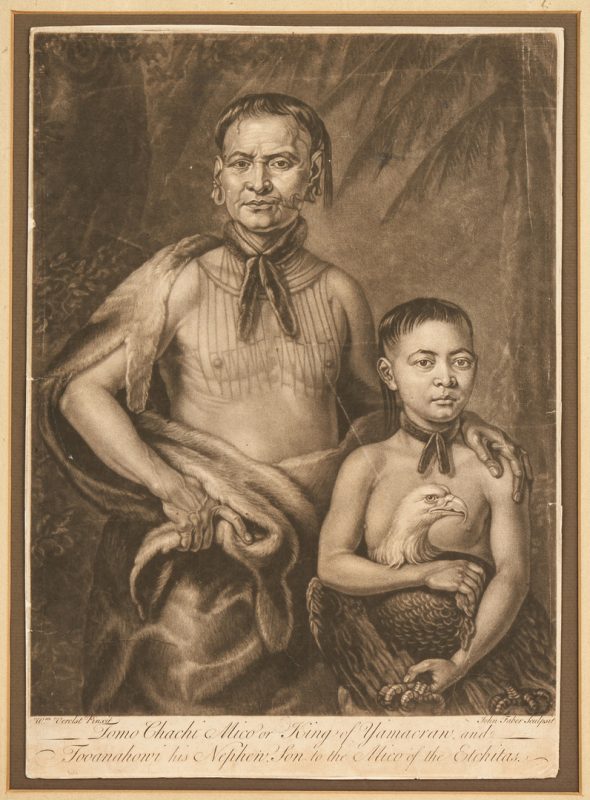 |
Colonial GA related print: Tomo Chachi Mico and his Nephew |  Important early Georgia related print depicting Tomochachi Mico or King of Yamacraw, and Tooanahowi his Nephew, Son to the Mico of the Etchitas. Circa 1734-1745 mezzotint engraving by John Faber the Younger (British, 1684-1756) after the painting by William Verelst (British, 1704-1752). Matted and housed under glass in a stained and ebonized wood frame. Sight approximately 14″ H x 9 7/8″ W. Sheet – 14 1/8″ H x 10″ W. Framed – 22 1/2″H x 17 7/8″W. Background information: (from The Museum of Early Southern Decorative Arts): “When James Oglethorpe (1696-1785) landed in Georgia in 1733 he worked to quickly cement a friendship with the Creek Indians. Oglethorpe established a particularly close relationship with Tomo Chachi Mico, King of the Yamacraw, part of the Creek nation. Tomochachi Mico and his nephew Tooanahowi accompanied Oglethorpe back to London in 1734. In London Tomo Chachi Mico and his nephew met the Trustees of the Georgia colony. That meeting is recorded in group portrait by the artist William Verelst now in the collection of the Winterthur Museum (acc. 1956.0567a). The pair also sat for a portrait, now lost, by Verelst. The two Georgia natives were a sensation in London, and soon after the portrait was completed it was engraved by John Faber. Though we know the men dressed in both English and native clothing while in London, they are depicted here in native clothing against an tropical background. Tomo Chachi Mico wears a deerskin cape over his shoulder, perhaps a symbol of the valuable deerskin trade with the English that the Creeks were engaged in. Tooanahowi holds an American bald eagle, a native symbol of peace and an example of the fauna of the new world.” Provenance: the estate of Victor T. Patterson, Franklin, TN. Note: born in Georgia and educated at the Parsons School of Design, Victor Patterson served as a cultural representative to Russia with Dwight D. Eisenhower’s “People to People” program (prior to its privatization) before moving to the Nashville, Tennessee area to pursue a career in interior design. He was associated with Bradford’s for many years before starting his own business. He decorated the Tennessee Governor’s Mansion and the home of several country music stars in the 1970s, and filled his home on Franklin’s historic Fourth Avenue with art and antiques from his frequent travels. CONDITION: Margins trimmed to plate. Print appears to be adhered to backing around perimeter. Light toning and foxing. Several creases resulting in white lines including across top, partial crease (vertical) upper right corner, diagonal across center touching Tomochachi’s chest and Nephew’s shoulder. 3-4 edge tears up to 1″. Couple small losses to edge, largest 1/2″L, barely extending into image. A few scattered pinpoint sized surface losses including two on Tomo Chachi’s face. Mat with grime and small losses, frame with abrasions and small losses. [See more photos →] |
$22,800.00 |
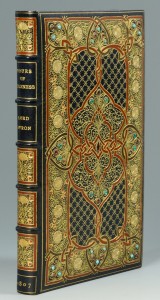 |
1807 Byron book, Cosway binding, Sangorski & Sutcliffe |  “Hours of Idleness” by Lord Byron (George Gordon Noel Byron), 1807, first edition second issue, with early 20th century jewelled Cosway-style binding by Sangorski & Sutcliffe, the interior containing miniature portraits of Lord Byron and his ancestral home, Newstead Abbey. Original silk and velvet lined leather bound case. Hours of Idleness was the first volume of poetry published by Byron at the age of 19, which launched his literary career. This book contains properties associated with the second issue (Page 114 line 4 “thunder”; Page 22, line 2 “those tissues of falsehood..”). 8vo., 187 pp., printed by S. & J. Ridge, Newark, England. The binding, likely made not long after the foundation of the famed Sangorski (Sangorsky) and Sutcliffe bookbinding business in 1901, is of full dark blue French Levant morocco, with fly leaves of brown watered silk and gilt edges. The front cover features applied jewels including 1 central marquis garnet, 8 green chalcedonies, 14 turquoises, and 16 round garnets. The design on both front and back features interlaced strapwork, dividing the cover into Gothic style panels filled with red, green and gilt floral decorations. The front doublure is inlaid with a hand painted miniature watercolor on ivory portrait of Byron, surrounded by a laurel wreath inset with 4 green chalcedonies and 4 topazes. The back doublure is inlaid with a miniature watercolor on ivory painting of Newstead Abbey. Book: 8-1/2″ x 5-1/2″. Provenance: Estate of Robert Keith, Brentwood, TN, listed Dawson’s Book Shop catalog in 1944, full provenance details available on request. Condition: Binding excellent. Book pages show light toning and minor foxing, overall very good condition. Case in fair condition with exterior wear and some small tears to silk. [See more photos →] |
$22,230.00 |
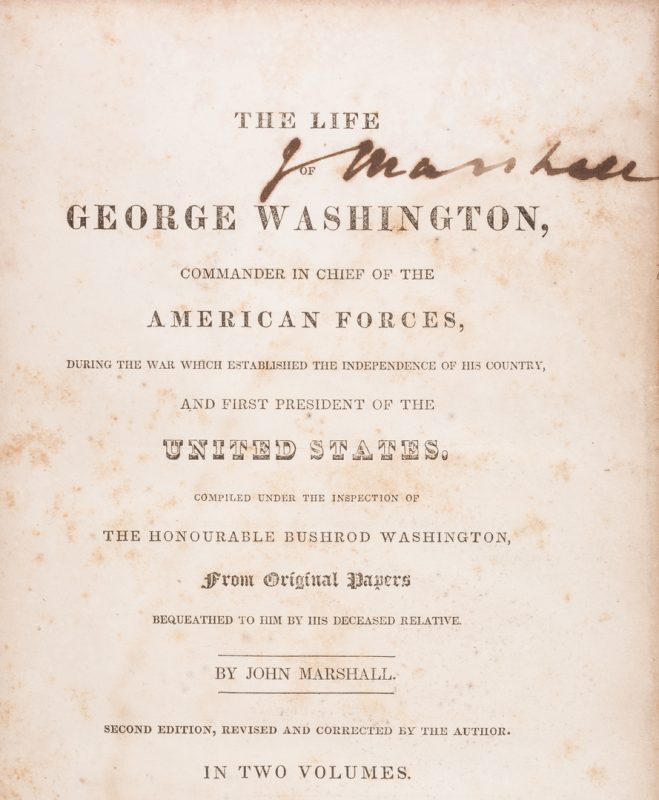 |
John Marshall’s 2 Volume Book: Marshall’s Washington, Signed by Marshall |  Signed hardcover two volume set of John Marshall’s “The Life of George Washington”, published by Carey & Lea, Philadelphia, 1832. Second edition, “Revised & Corrected by the Author”. Stereotyped by J. Chrissy & G. Goodman. Volume I – 460 pages and 42 pages of notes. Volume II – 448 pages and 32 pages of notes. 8vo, calf leather cover, black leather spine labels, marbled endpapers and endpages. Engraved frontispiece portrait of Washington in Volume I. Errata Sheet with hand written notes included in Volume II. The first volume is inscribed “For Mr. James K. Marshall From his affectionate Father The Author”. The second volume is signed “J Marshall” on the title page. Provenance: The Estate of Charles Boyd Coleman, Jr., Chattanooga, TN, by descent from Lewis Minor Coleman, Jr., son of CSA Lt. Colonel Lewis Minor Coleman and Mary Ambler Marshall, daughter of James K. Marshall and granddaughter of John Marshall (1755-1835). Lewis M. Coleman Jr. was also related to the family of Henry Dearborn by his marriage to Julia Wingate Boyd, daughter of Annette Maria Dearborn Boyd, who was the daughter of Greenleaf Dearborn (1786-1846) and great granddaughter of Henry Dearborn (1751-1829) on her mother’s side. John Marshall was the fourth Chief Justice of the United States, serving for thirty-five years. He oversaw landmark decisions such as Marbury v. Madison, McCulloch v. Maryland, Gibbons v. Ogden and the Dartmouth College case. His lifelong friendship with George Washington developed during their Revolutionary War service including the winter at Valley Forge and the battles at Brandywine and Monmouth. (See related lot #264). Description courtesy of Stuart Lutz Historic Documents, Inc. CONDITION: Original cover with wear to the front boards and some wear to the spines. There is scattered foxing throughout but a fine association copy. Volume 1 with minor loss to lower back endpaper. Inscriptions and signatures clean and crisp. [See more photos →] |
$21,600.00 |
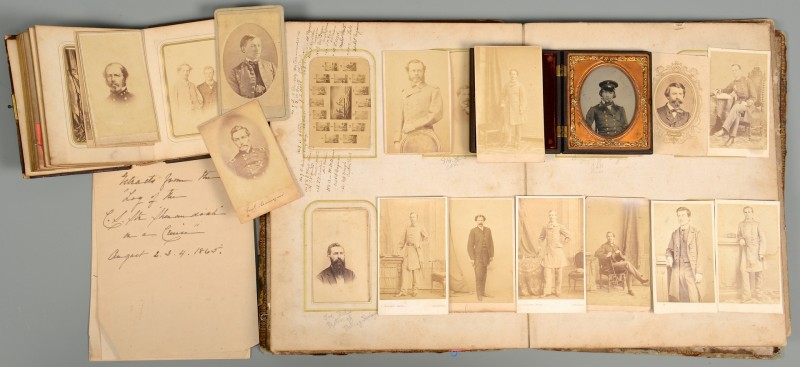 |
Confederate Naval CDV Album Archive – CSS Shenandoah, Florida, Alabama |  Important Naval Photographic Archive CDV Album of Lieutenant Dabney Scales of the CSS Shenandoah including images of uniformed and non-uniformed Confederate Naval officers from the CSS Shenandoah, CSS Florida, and the CSS Alabama, a 1/4 plate ambrotype of Dabney Scales in uniform, and extracts from the log of the CSS Shenandoah from August 2-5, 1865 detailing the encounter with the British ship, Barracouta, and learning of the overthrow of the Confederate government. Note – the Confederate ship, CSS Shenandoah, fired the last shot of the Civil War and marked the final surrender of Confederate forces on November 6, 1865. Given the orders to destroy the New England whaling fleet, the partially crewed Confederate ship circumnavigated the earth, capturing 38 vessels and taking over 1000 prisoners between 1864-65. Twenty-five ships were captured after the Confederacy had collapsed. 1st grouping – CDV album of Dabney Scales dated July 15, 1863 Paris, France on inside cover and a second, smaller CDV album marked Havana June 1, 1863. Interior contains several CDVs of fellow Confederate Naval officers, women acquaintances, and European subject matter including works of art and famous Europeans. A couple of notable women with signed CDVs to Scales include Rosa Bonheur (realist painter, sculptor) and Lillie W. Hitchcock (Coit). Of the approximately 25 identified Confederate naval Officers, 15 are in uniform. An additional eight CDVs of males in formal attire are likely Confederate Naval officers but have yet to be identified. Identified Naval officers of the CSS Shenandoah include Lieutenant Dabney Scales (signed), William Breedlove Smith, Paymaster (signed), Dr. Fred McNulty, ship assistant surgeon (signed), Lt. John Grimball, Lt. William C. Whittle (signed Jack), William Breedlove Smith (w/out uniform), Edwin G. Booth (assistant surgeon?), Midshipman John T. Mason, and Chief Engineer Matthew O’Brien. Joe Scales (Confederate Army), Dabney”s brother, is also pictured and signed en verso. Three formally attired gentleman with Liverpool marked CDVs are likely Shenandoah crew members. Uniformed Confederate Naval officers of the CSS Florida include Lt. Sardine G. Stone (signed), a CDV of the CSS Florida with small images of each crew member surrounding the Florida ship image (each officer identified), Lt. Midshipman R.S. Floyd, Lt. George Dwight Bryan (became mayor of Charleston after war), Lt. Sardine G. Stone pictured with another male, and Lt. James Lingard Hoole pictured with another male, CDV of non-uniformed male (possibly T.T. Hunter). Uniformed Confederate Naval officers of the CSS Alabama include Lt. Joseph D. “Fighting Joe” Wilson, Midshipman E. R. Anderson, Lt. Richard F. Armstrong, and Midshipman Eugene Anderson Maffit, and possibly Surgeon Galt. Other CDV s Confederate officers in the smaller album lot include P. T. Beauregard with an Augusta, GA label, an unidentified officer with a Louisville, KY label, and a CDV of Confederate General Joe Johnson. 2nd grouping – Extracts from the “Log of the C.S.S. Shenandoah on a cruise Aug 2-3-4 1865 with course headings, latitude and longitude for each day. August 2, 1865 reads, “Got Steam and stood in chase. Took in all sail except the head sails. At 4:15 came up with chase stopped the engine & sent a boat along side the English barque “Baracuta from San Francisco bound to Liverpool. 13 days out ——– Having received by the barque Barracouta the sad intelligence of the overthrow of the Confederate Government. All attempts to destroy the shipping on property of the Northern States will cease from this date. In accordance with which the First Lieutentant W. C. Whittle Jr. received the order from the Commander to strike below the battery and disarm the ship & crew.” 3rd item – 1/4 plate size ambrotype of Confederate Dabney Scales in an early Naval uniform. Hand tinted buttons and lapel highlighted in gold. Littlefield, Parsons & Co. case patented 1856 & 1857 with a beehive and farm implements pattern on front and back. Provenance: Direct descendant of Lt. Dabney Scales. CONDITION: 1st grouping – larger album with spine and covers loose with losses. CDVs overall very good condition with a couple showing more foxing near the back of the larger album, some CDVs with edges trimmed. 2nd item – extract pages in overall very good condition with pages very legible. 3rd item – ambrotype image with scattered losses to the face area. [See more photos →] |
$20,460.00 |
 |
Benjamin Tyler 1818 Copy of the Declaration of Independence |  Scarce Benjamin Owen Tyler 1818 copy of the Declaration of Independence, engraved by Peter Maverick, Newark, NJ; considered the first copy of the Declaration produced for commercial purposes. Engraved on laid paper with eagle watermark. Housed under glass in a later ebonized frame. Plate: 29 1/4" H x 23 1/2". Sheet: 31 3/4" H x 25 5/8" W. Framed: 37 1/2" H x 31 1/2" W. Note: The University of Virginia Library, which maintains a permanent exhibition of copies of the Declaration of Independence, notes, "In 1815, the United States concluded its second war with Britain, the War of 1812, and American nationalism blossomed in its wake. Reinforcing this renewed patriotism, the passing of the signers' generation created a passionate interest in all things associated with the nation's founding. Several entrepreneurs sought to capitalize on this demand by rushing to produce the first facsimile printings of the Declaration of Independence — offering the American public its very first look at the document. In 1818, Benjamin Owen Tyler produced the first facsimile of the Declaration." (source: https://explore.lib.virginia.edu/exhibits/show/declaration/exhibit). Note: The Massachusetts-born Tyler (b. 1789-d. ca. 1855) was a penmanship professor, who painstakingly hand copied the signatures of the original signers on America's foundation document. An estimated 1,740 copies were produced, and sold by subscription; an unknown number survive. Those placing orders included multiple founding fathers, notably the Declaration author Thomas Jefferson himself. The endorsement of Richard Rush, son of signer Benjamin Rush, and acting Secretary of State in 1817, appears in the bottom left corner of the document: "The foregoing copy of the Declaration of Independence has been collated with the original instrument and found correct. I have myself examined the signatures to each. Those executed by Mr. Tyler are curiously exact imitations, so much so, that it would be difficult, if not impossible, for the closest scrutiny to distinguish them, were it not for the hand of time, from the originals." PROVENANCE: The collection of the late Fount and Ida Smothers, Thompson's Station, Tennessee. CONDITION: Masking tape repairs to: Upper masthead area (two intersecting tears 6" and 6", affecting words July 4 and America); Left edge (1 1/2", 2", 6", 3 1/2"), Lower edge (3 1/2"), and Right edge (1 1/4"). 7" liquid stain to upper left ledge. 7" tape reinforcement lower right edge. Some minor chipping to all edges. Tiny puncture over facsimile signature of Charles Carroll of Carrolton. Scattered creasing. Light toning. [See more photos →] |
$20,400.00 |
 |
Confederate CSS Shenandoah Diary and Archive |  Important 1865 Confederate CSS Shenandoah ship diary archive of Lieutenant Dabney Scales including 1865 diary journal (85 pages, 104 pages total), an ambrotype and CDV of Lt. Dabney Scales in uniform, a CDV of the Shenandoah, and an author signed book/pamplet titled, “Cruises of the Confederate States Steamers “Shenandoah and “Nashville by Captain William C. Whittle, 1910. Note – the Confederate ship, CSS Shenandoah, fired the last shot of the Civil War and marked the final surrender of Confederate forces on November 6, 1865. Given the orders to destroy the New England whaling fleet, the partially crewed Confederate ship circumnavigated the earth, capturing 38 vessels and taking over 1000 prisoners between 1864-65. Twenty five ships were captured after the Confederacy had collapsed. Biography of Dabney Scales – Dabney Minor Scales (1841-1920) of Memphis, TN was the son of Peter Scales, a planter originally from Virginia. Dabney was born and raised in Holly Springs, Mississippi, attended the US Naval Academy and joined the Confederate Navy at the outbreak of the Civil War. He served on the CSS Savannah, CSS Capital, CSS Arkansas, CSS Atlanta, and the CSS Shenandoah. In 1863-4, Scales was assigned to Europe and spent time in London and Paris regarding the outfitting and manning of Confederate ships constructed in England. Fearing he would be prosecuted as a pirate after the Civil War, Dabney Scales lived in Mexico for a short time, but was back in the States practicing law in Memphis by about 1869. He married Susan Winchester Powell (granddaughter of Gen. James Winchester) in Nashville circa 1885 and was elected to the Tennessee legislature and served in the Tennessee State Senate 1895-1896. He returned to active Naval duty in the Spanish American War, serving as a lieutenant despite his age. 1st item – CSS Shenandoah ship diary of Lieutenant Dabney Scales, 85 pages with some hand drawn illustrations. Complete diary has a total number of 104 pages and includes a partial journal by a different hand from May 1864 – December 1864 relating to the ship Edward of New Bedford – the first whaling vessel captured by the Shenandoah, and two pages of an 1870 entry by Dabney Scales. The log of the Shenandoah is titled “Confederate States Shenandoah cruising for Yankees. Scales retroactively records events back to February 13th, 1865 in Melbourne, Australia where the Shenandoah was dry docked for repairs. The diary goes into extensive detail on major events including the encounter with authorities in Melbourne and Liverpool, the capturing of vessels and crews for the year 1865, encounters with the natives, and interactions among Shenandoah officers. A June 22nd entry refers to the “Sophia Thorton” ship Lt. Scales boarded. The ship “made some show of escape by standing on through the ice, but a shot from one of the rifle guns brought her to.” He continues, “out of these vessels we have heard the most disheartening news I have ever heard from our poor suffering country. The captures of Savannah, Charleston, ..Richmond together with the surrender of Lee, with an army of 22,000 men – with this also comes the tradgical death of the “Rail Splitter” by the hand of an assasin. This will, of course, make a hero of him –. His last entry on this day, “To the part of this news relating to the surrender of Lee”s army + the disbanding of those not surrendered, I give no credence at all……I think however we should struggle on to the last, and if as the yankee papers say —Davis crosses the Mississippi to establish a Confederacy there. I for one shall follow and join him rather than subject to Yankee rule. On August 3rd, Lt. Scales writes, “How shall I attempt to describe the change that has come over the officers and crew of this ship within the last twenty four hours. I can only write a few unintelligible words that may serve to recall to my mind what my own feelings were yesterday afternoon…we came in sight of a sail – the first seen since we left the Arctic… Barracouta (ship) – boarded her and brought off the news – My G.! What news it was for us…. I was therefore in a measure prepared for either good or bad news but not for such as was in store for me….The only words I caught were – “All over – President Davis and cabinet prisoners in New York – All organized armies surrendered…” Upon arriving at Liverpool in November 1865, Dabney Scales writes on November 6th – “The (British) pilot boarded us in the mid watch this morning. His news confirms that given us by the “Barracouta – the downfall of the Southern Confederacy. The war, he said had been over so long that people had forgotten all about it. While many of these events have been published in previous books on the Shenandoah, this diary represents new primary source material previously unavailable. Regarding the partial journal of the whaling ship “Edward starting May 5th 1864 and ending December 1st 1864 (17 pages), the author writes of Right whales sightings and discusses and event Nov. 29th where a whale was struck and capsized the boat. 2nd grouping – 1/4 plate ambrotype of Confederate Dabney Scales in uniform with hand tinted gold highlights, CDV of Lt. Dabney Scales taken in Melbourne, Austrailia. Marked verso “Johnstone & Co. Melbourne, 3 7/8″ x 2 1/2″, and a CDV of the ship, CSS Shenandoah, 3 3/4″ x 2 3/8”. Last item – Author signed book/pamplet titled, “Cruises of the Confederate States Steamers “Shenandoah and “Nashville by Captain William C. Whittle, 1910. Page 32 signed, “For D. M. Scales from Yours Sincerely Wm C Whittle March 31st 1910”. Cover is marked in black pen, “Dabney M. Scales compliments of the Author. Provenance – Direct descendant of Lt. Dabney Scales. CONDITION: 1st item – Journal missing cover, binding loose and frayed, several pages separated, edges of several pages charred and worn. All pages appear to be legible. Diary page size 8 1/2″ x 13 3/8”. 2nd item – Ambrotype with cover unattached, Dabney Scales CDV with tape verso, Shenandoah CDV trimmed. and CDVs in verso. 3rd item – pamplet/book in overall very good condition with some browning to covers. [See more photos →] |
$19,470.00 |
 |
George Washington Signed Letter to John Marshall |  George Washington handwritten letter to John Marshall (ALS), congratulating him on his first election to a Federal Office: “With Infinite Pleasure I Received The News Of Your Election…a Few Days Now, Will Give Us The Result Of All The Elections To Congress & The Legislature Of The State”. GEORGE WASHINGTON (1732-1799). Washington was the Commander-in-Chief of the Continental Army, President of the Constitutional Convention, signer of the Constitution and First President of the United States. JOHN MARSHALL (1755-1835). Marshall was the fourth Chief Justice, serving for thirty-five years. He oversaw landmark decisions such as Marbury v. Madison, McCulloch v. Maryland, Gibbons v. Ogden and the Dartmouth College case. ALS. 1pg. May 5th, 1799. Mount Vernon. An autograph letter signed “Go:Washington” and accompanied by a free franked address panel also signed “Go:Washington”. The former President wrote to John Marshall, congratulating Marshall on his election to the United States House of Representatives from the Richmond area. Washington hand wrote to the future Chief Justice (missing words are put in brackets): “With infinite pleasure I received the news of your Election. For the Honor of the District, I wish the Majority had been greater, but let us be content, and hope, as the tide is [turning, the current] will soon run strong on our favor. [I am] sorry to find that the publication [you allude to] should have given you a moments [disquiet] I can assure you, it made no im[pression on my] mind, of the tendency apprehend[ed by you]. [The] doubt you have expressed of Mr. [Hancock’s ele]ction, is unexpected as it is pain[ful in these] parts, we had set it down as cer[tain, and our] calculations went to eleven instead of nine. A few days now, will give us the result of all the Elections to Congress & the Legislature of the State; and as you are at the fountain of information respecting the politics of the members, give me, I pray you, the amount of the parties on each side, if you have the leisure & can ascertain them. With very sincere esteem & regards I am–Dear Sir–Yr Obedt & Affect Servt Go:Washington”. The address panel is in WashingtonÂ’s handwriting, and he sent it to “General Marshall in Richmond Go:Washington”; there is additional writing probably by a local postmaster. Includes dedication card reading “Presented to Louis Minor Coleman by his Aunt- Alice Marshall Coleman”, affixed to lower right corner of letter. Letter is mounted to grey card stock board. Letter – 9 3/4″ H x 16 1/4″ W. Board – 10″ H x 16 1/4″ W. Typed letter from Herbert A. Johnson, Associate Editor of “The Papers of John Marshall”, to Charles B. Coleman, Esq., dated February 26, 1968, included in lot. Provenance: The Estate of Charles Boyd Coleman, Jr., Chattanooga, TN, by descent from Lewis Minor Coleman, Jr., son of CSA Lt. Colonel Lewis M. Coleman and Mary Ambler Marshall, daughter of James K. Marshall and granddaughter of John Marshall (1755-1835). Lewis M. Coleman Jr. was related to the family of Henry Dearborn by his marriage to Julia Wingate Boyd, daughter of Annette Maria Dearborn Boyd, who was the daughter of Greenleaf Dearborn (1786-1846) and great granddaughter of Henry Dearborn (1751-1829) on her mother’s side. Note: This was not Marshall’s first political victory. In 1782, he was elected to the Virginia House of Delegates, and remained there for seven years; he was again elected to the Virginia House from 1795 to 1796. In 1788, Marshall served as a delegate to the Virginia convention that ratified the new Federal constitution; Marshall was a staunch supporter of the new government. He declined Washington’s offer of Attorney General. During the Adams administration, he declined an appointment to the Supreme Court, but he represented the United States during the infamous XYZ Affair. His 1799 election to the House of Representatives was his first Federal victory; Marshall was helped because of his support from Patrick Henry. In 1800, President Adams named Marshall Secretary of State and the next year, Adams nominated him to become the fourth Chief Justice. The “Mr. Hancock” mentioned is most likely the Virginia Congressman George Hancock, who served in the House of Representatives from 1793 to 1797. The letter and attached address leaf are glued to a larger board and framed; paper loss affects about twenty words. The Library of Congress owns a letterbook copy of this letter and the missing words can be ascertained. According to The American Book Prices Current (a compendium of auction results), only three Washington to Marshall letters have sold in the past quarter century. A 1968 letter from Herbert Johnson, the Associate Editor of the Papers Of John Marshall, states “This is such an important letter that I know you value it highly. As you may know Washington was the most important influence that impelled Marshall to stand for election in the House of Representatives. This was his first domestic office with the national government and from it he moved to the State Department and then the Chief Justiceship…Washington’s request that Marshall provide him with the Virginia election returns–another indication of Marshall’s position in the Federalist party in Virginia…”. An additional letter included in this lot is dated June 1913 from United States senator/historian Albert J. Beveridge and reads, “Dear Mr. Coleman: Miss Lizzie Marshall of Leeds, VA informed me that you have some letters of Chief Justice Marshall – one of them from George Washington.” (Beveridge states he is gathering material to write the The Life of John Marshall and would like copies of the letters.). A great association between the first President and the great Chief Justice. Description courtesy of Stuart Lutz Historic Documents, Inc. CONDITION: Overall good condition. Washington signature and writing in strong, clear condition. Areas of dampstaining, including faint 3/4″ x 1 1/2″ dampstaining over signature (does not affect overall quality). 3 3/8″ x 2 1/4″ area of text missing from left margin of letter (3 3/8″ x 6 1/2″ area missing in total extending from below address to left horizontal fold line). 1/2″ x 3/8″ area of lower right corner repaired (does not affect signature). [See more photos →] |
$19,200.00 |
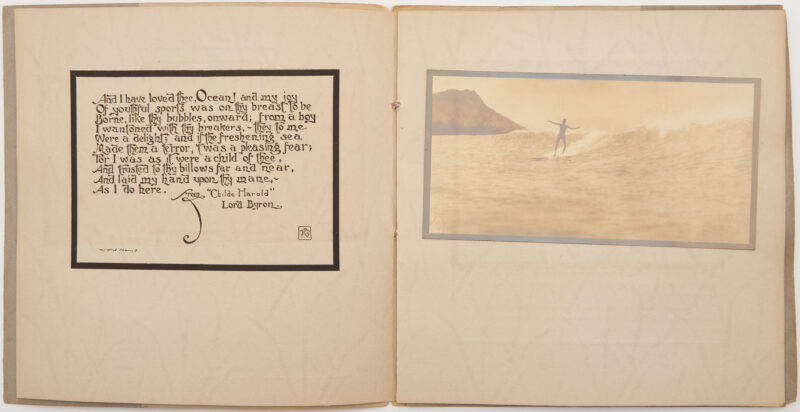 |
Scarce A.R. Gurrey book: Surf Riders of Hawaii, c. 1911-15 |  THE SURF RIDERS OF HAWAII, Gray Version, photographs and contents copyrighted by Alfred Richard Gurrey, Jr., Ltd., Honolulu, T. H., circa 1910-14. Softcover, 6 leaves of gray and taupe decorative cover stock paper with 8 mounted gelatin-silver photographs of Waikiki surfers, including Duke Paoa Kahinu Mokoe Hulikohola Kahanamoku (1890-1968), who popularized the sport of surfing. With English text, stab-sewn into gray decorative cover stock paper wrappers with printed black title lettering to front cover. 7 1/2″ H x 7 1/2″ W. Rare. This important, hand made publication is the first known book dedicated entirely to surfing and has been credited with inspiring the genre of surf photography. In their 2005 Surfer’s Journal article, “A.R. Gurrey, Jr: The Genesis of Surf Photography,” Joel T. Smith and Sandra Kimberly Hall write “This photo compilation doesn’t just document wave riding, it endows the sport with an almost ethereal sense of splendor.” Fewer than ten original copies are known. This copy was discovered in the estate of an Ohio antiques dealer, who acquired it in a collection of books from a descendant of Maui businessman Henry Perrine Baldwin outside Cleveland in the late 1980s (along with the book IDYLS OF HAWAII, see lot 701). This copy has never before been offered at auction. According to Tim DeLaVega, author of 200 YEARS OF SURFING LITERATURE, there were two different original versions hand made by A.R. Gurrey between circa 1911 and 1915: the Taupe version and the Gray version. There are two other documented copies of the Gray Version, including one that is listed in THE PRELIMINARY CATALOGUE OF HAWAIIANA IN THE LIBRARY OF GEORGE R. CARTER, Honolulu, 1915, p. 166 and was donated to the Mission House Museum in Honolulu in 1916. The other was purchased by the Spanish Counsel Ignacio de Arana (1880-1918), who arrived in Honolulu in September 1911 and left in 1912. The book can be seen in the exhibit SURF X 100 1912-2012, at the Maritime Museum of Bilbao, Spain.” This is the first time, to our knowledge, that any of the Gray versions have ever been offered at auction. Biography: Alfred Richard Gurrey, Jr. was born in Kansas, graduated from UC-Berkeley, and worked as a civil engineer in the San Francisco area before moving to Hawaii around 1900. His parents had moved there in 1899, because his father, Alfred Sr. (1852-1944), was the principal insurance adjuster for the island chain, drafting the first fire ratings and maps for the city of Honolulu. His father, an artist in his own right, later became well known for his oil paintings. Gurrey, Jr. initially worked in Hawaii as a surveyor but quit to become a gallerist, establishing A. R. Gurrey, Jr. in 1902. The following year he married his wife, Caroline Gurrey, a talented photographer. In 1908 the Gurreys bought out the Hawaiian Photo Supply Co. and a year later, Gurrey Ltd. opened as the Hawaiian agent for Ansco films and cameras and Cyco printing paper. Soon thereafter Gurrey won the contract to handle all the photographing, developing and printing for the U.S. Naval Yard at Pearl Harbor. According to biographers Joel T. Smith and Sandra Kimberley Hall, there is no indication that Gurrey ever received formal training in photography. While his wife’s expertise may have been influential, their work differed: Caroline worked with carefully composed and lit subjects in her studio, while A. R. did virtually all of his photography outdoors. Gurrey was also an avid surfer and member of the Hui Nalu, the surfing club founded by future Olympic surfer Duke Kahanamoku and his friends. Gurrey’s photographs are said to be the earliest known photos of Duke surfing, taken before his first Olympics in 1912. Gurrey published some of his photographs in Hawaiian and national publications, but for some reason Gurrey seemed to stop taking photographs shortly after the publication of ‘Surf Riders.’ He concentrated on his art gallery, but the company encountered financial problems and closed permanently in 1923. Around the same time, the Gurrey’s home was hit by both a fire and a flood. It is believed that all of their original negatives were lost. Gurrey went into the insurance business and Caroline, who had continued with her photography, died at age 52 in 1927. Gurrey died a year later at the age of 53. In the years that followed, Gurrey’s name was often confused with that of his father, who outlived him by nearly two decades. His name and work were essentially forgotten until the publication of a Surfers Journal article in 2005, by Joel T. Smith & Sandra K. Hall, from which this biographical information was obtained. (Ref. “A. R. Gurrey, Jr.” from The Surf Riders of Hawaii blog, by Joel T. Smith and Sandra Kimberley Hall, https://surfridershawaii.blogspot.com/p/ar-gurrey-jr.html). PROVENANCE: Acquired from the estate of Carol Illner of Ohio, who acquired it in a collection of books from a direct descendant of Arthur Douglas Baldwin, son of Maui entrepreneur Henry Perrine Baldwin (see lots 700-704 from this collection, also in this auction). CONDITION: Covers with light toning, waviness, handling wear with minute tears to top and bottom of spine, largest 1/8″, ribbon cord to spine is intact, corners slightly bumped. Pages and photographs with light toning, general handling wear, waviness to pages. All photographs are present. [See more photos →] |
$19,200.00 |
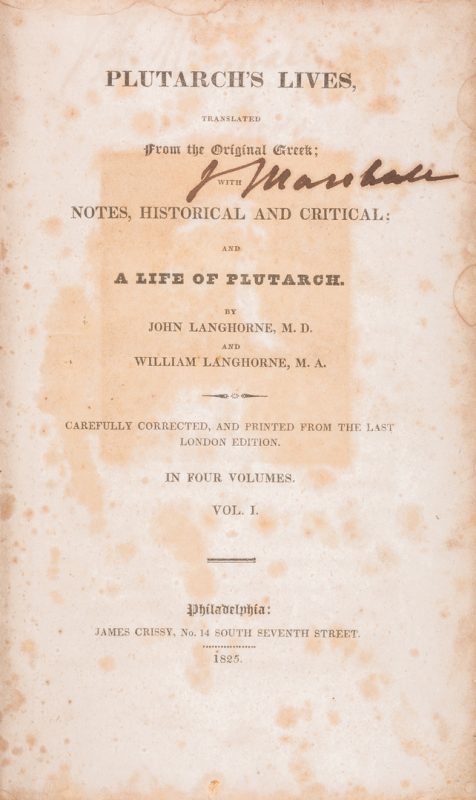 |
John Marshall Signed 4 Volume Book Set: Plutarch’s Lives |  John Marshall signed, four (4) Volume Book Set: “Plutarch’s Lives, Translated from the Original Greek, with Notes, Critical and Historical; and a Life of Plutarch” by John and William Langhorne, Carefully corrected and printed from the last London Edition, 4 volumes. Published James Crissy, Philadelphia, 1825. 8vo, calf leather cover, and black leather spine labels. All volumes signed by original owner, Chief Justice John Marshall (1755-1846) on the title page. Additionally, each volume bears the inscription: “Lewis Minor Coleman, Jr. /1911/from his grandmother Mary Ambler Marshall Coleman” on the inside front cover. Volumes I, II and IV bear the additional signature of James K. Marshall, son of John Marshall. All four volumes are signed “J Marshall” on the title page. Provenance: The Estate of Charles Boyd Coleman, Jr., Chattanooga, TN, by descent from Lewis Minor Coleman, Jr., son of CSA Lt. Col. Lewis M. Coleman and Mary Ambler Marshall, daughter of James K. Marshall and granddaughter of John Marshall (1755-1835). Lewis M. Coleman Jr. was also related to the family of Henry Dearborn by his marriage to Julia Wingate Boyd, daughter of Annette Maria Dearborn Boyd, who was the daughter of Greenleaf Dearborn (1786-1846) and great granddaughter of Henry Dearborn (1751-1829) on her mother’s side. American politican John Marshall was the fourth Chief Justice of the United States Supreme Court, serving for thirty-five years. He oversaw landmark decisions such as Marbury v. Madison, McCulloch v. Maryland, Gibbons v. Ogden and the Dartmouth College case. Marshall also was a friend and attorney to George Washington, and was one of the first President’s early biographers (see related lot, #263 in this auction). Description courtesy of Stuart Lutz Historic Documents, Inc. CONDITION: Wear and losses to covers, especially to Volume IV. Interiors with scattered foxing, toning and some dampstaining to all volumes. Inscriptions and signatures clean and crisp. Volumes II & III with pencil doodles and marks to the back free papers. The calf is rubbed and scratched. A fine set. [See more photos →] |
$18,600.00 |
 |
19th C. Bird’s Eye View, Univ. of Virginia and Charlottesville from Lewis Mountain |  Mid-19th century birdseye view of the Charlottesville, Virginia, area, graphite on cardstock, titled on two separate caption strips in faint period hand-written pencil script: THE UNIVERSITY OF VIRGINIA / CHARLOTTESVILLE AND MONTICELLO IN THE BACKGROUND / TAKEN FROM LEWIS MOUNTAIN. The panoramic view shows the Lawn of the original grounds of the University of Virginia, including the Annex to the Rotunda (constructed 1851-54, destroyed by fire in 1895), and the Anatomical Theater (completed in 1828, partially destroyed by fire in 1886, restored with modifications in 1888). The town of Charlottesville and Monticello Mountain are visible in the background. Unsigned. The drawing shows numerous similarities, and is possibly related, to the lithograph of the same subject and title drawn by Edward Sachse (1804-1873) of Sachse & Co. and published by Casimir Bohn in 1856, although it lacks several details (including the horses seen in the upper right foreground of the print). Sachse & Co. was responsible for several mid-19th century views of American towns including: Richmond, VA (1851), Norfolk, VA (1851), and Alexandria, VA (1854). Other artists drawing views of Virginia during the period included James T. Palmatary, John Serz (who also did an engraving of the University of Virginia for Bohn), Edward Beyer and David Hunter Strother. Housed in an early, possibly original silver-gilt molded wood frame; framing materials include square nails. Sketch – 11″ H x 18″ W. Sight – 11 7/8″ H x 17 7/8″ W. Framed – 15 1/4″ H x 21″ W. Provenance: Nashville, Tennessee, estate, descended in an early Charlottesville, Virginia, family. CONDITION: The drawing itself is in overall good condition with some minor losses upper margin, primarily at corners, and edge toning. Significant toning and some dampstaining to paper below sketch, with significant fading to penciled writing on captions. Sketch and caption strips are not adhered to backing. Frame: shrinkage and scattered oxidation and wear to frame, losses to upper left corner, right center margin; retains much of original gilding. [See more photos →] |
$18,560.00 |
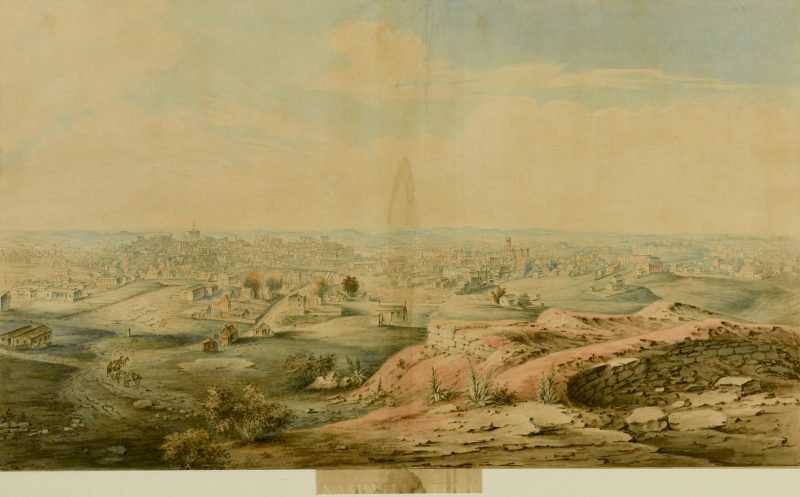 |
19th c. Watercolor View, Nashville from Ft. Negley |  “Nashville Panorama,” an important and large circa 1880 watercolor view of the city of Nashville from Fort Negley (built during the Civil War by Union troops and freed slaves). Visible are many Nashville landmarks including the Tennessee State Capitol, the University of Nashville, Howard School, and the Cumberland River, along with churches, brick and log homes, various figures, horses and carriages. Unsigned, artist unknown. Titled NASHVILLE TENN. lower margin. 21″ x 36″ sight, 29″ x 42″ matted and framed. Published, “The Tennessee Historical Quarterly: Landscape and Genre Painting in Tennessee, 1810-1985″ by James C. Kelly, Tennessee Historical Society, 1985. Exhibited, The Tennessee State Museum, Nashville, Sept. 5-Nov. 20, 1985; Dixon Gallery, Memphis, Dec. 1-Jan. 15, 1986; Hunter Museum of Art, Chattanooga, Feb. 6-March 31, 1986, and the Dulin Gallery of Art, Knoxville, April 10-May 11, 1986. Provenance: the estate of Sarah Hunter Hicks Green, formerly of Historic Devon Farm, Nashville, Tennessee. CONDITION: 15″ light water stain down center, a couple of 1/2” areas of discoloration in the sky, overall light toning and fading. Examination out of frame reveals margins present and watercolor is not mounted or glued down. Later frame. [See more photos →] |
$17,980.00 |
 |
Cormac McCarthy, Blood Meridian, 1st Edition, Signed |  BLOOD MERIDIAN or THE EVENING REDNESS IN THE WEST, by Cormac McCarthy, Random House, New York, 1985. Presentation copy, warmly inscribed on the ffep (front free end paper) to McCarthy's long-time friends, "For John & Lanelle / With much love / Cormac". 1st/1st, Stated First Edition on copyright page with correct Random House number line "24689753" indicating First Printing. Octavo, G/G, publisher's red boards with red cloth spine, slightly off-white, original unclipped price of $17.95. Jacket housed in archival protector. 8 1/2" H x 6" W x 1 1/4" D. PROVENANCE: Collection of the original giftee, East Tennessee. CONDITION: Book is Good with slight looseness, toning and foxing to top edge, slight foxing to fore and bottom. DJ (dust jacket) is Good with some 1/8" chipping along top of front, spine and rear. [See more photos →] |
$15,600.00 |
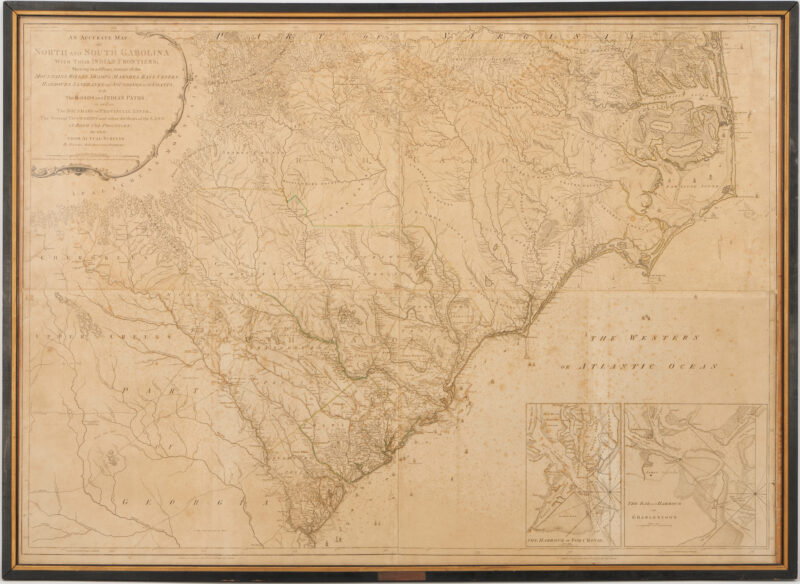 |
Henry Mouzon 1775 1st State Map of North / South Carolina With Indian Frontiers |  Important American Revolutionary War era map: AN ACCURATE MAP OF NORTH AND SOUTH CAROLINA WITH THEIR INDIAN FRONTIERS, First State, by Henry Mouzon and Others, published by Robert Sayer and John Bennett, London, 1775. Copperplate engraved map in four parts with hand-coloring depicting North Carolina and South Carolina, with parts of Virginia and Georgia, with boundary lines, counties, territories including Native American lands, cities, towns, bodies of water, mountains, forts, and other strategical and topographical points of interest identified in English text. Includes two inset maps, one (1) titled "The Harbour of Port Royal" and one (1) titled "The Bar and Harbour of Charlestown" lower right. Decorative title cartouche with scale of miles, top left. Surrounded by scale notations and a line border. Metal placard affixed lower center of frame. Housed under glass in an ebonized frame with gilt trim. Sight: 41" H x 57 1/4" W. Framed: 43 1/4" H x 59 1/2" W. Note: Published just weeks after Battles of Lexington and Concord, fought on April 19, 1775, this map was utilized by British, French, and American war commanders (including George Washington) due to its highly detailed geographical and topographical representation of the Carolinas. The absence of "Fort Sullivan" on "The Bar and Harbour of Charlestown" inset map indicates that this is the first state of this map. Ref: Cumming, William, North Carolina in Maps, pp. 21-22; Cumming, William, The Southeast in Early Maps, #450, pp. 449-450; Pritchard and Taliaferro, Degrees of Latitude: Mapping Colonial America, #44, figures 163, 164, pp. 208-211. PROVENANCE: Private West Tennessee Collection. CONDITION: Originally printed in 4 sheets, which have been adhered to an auxiliary card stock backing. Overall toning/acid burn and foxing spots to sheets. Pencil numeral, top left above image. Tears, largest 4 3/4", minor areas of loss to left and right edges. Not examined outside of frame. [See more photos →] |
$15,360.00 |
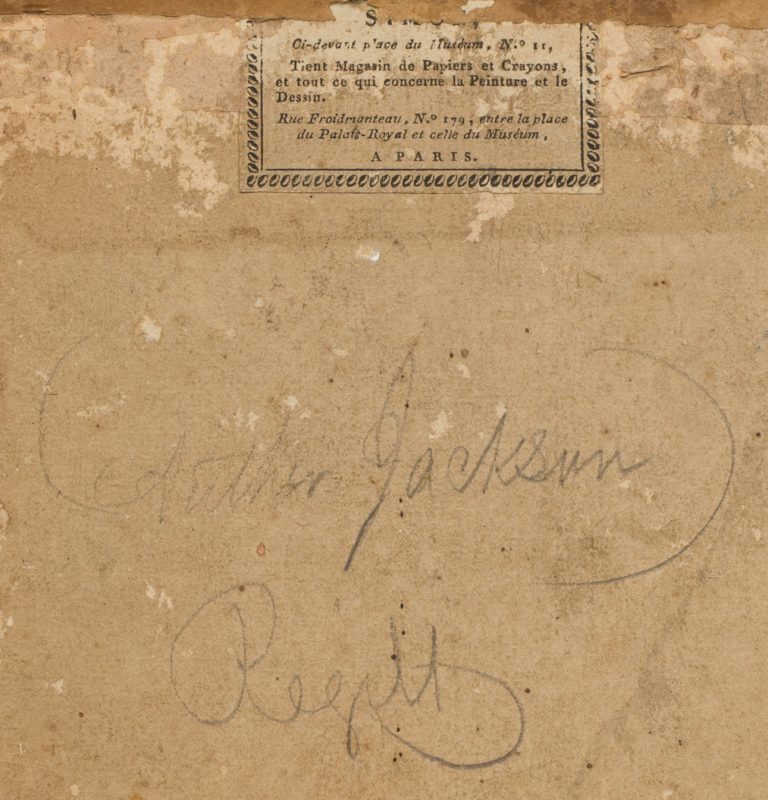 |
John Vanderlyn 1804 Portrait, possibly Thomas Jefferson |  John Vanderlyn (New York, 1775-1852) ink wash, conte crayon and graphite oval portrait, possibly Thomas Jefferson, signed in pencil, “J. Vanderlyn,” in margin lower left, and in pencil “at Paris 1804,” in lower right margin. Paris, France artist supply store label en verso (partially hidden by brown tape). Oval image – 8-1/2″ x 6-1/2″. Oval image with border – 9-11/16″ x 7-1/2″. Board – 10-3/4″ x 8-1/2″. Framed – 15″ x 12-3/4″ x 2″ D. Early 19th century two-inch wide giltwood and composition frame having concave outer edge, applied acanthus and palmette decoration, concave burnished band and bead course interior edge. Note: A similar image of Thomas Jefferson at about this age can be seen on a Staffordshire historical transferware pitcher sold at Northeast Auctions, August 21-22, 2010, lot 765. See the link to this pitcher at: http://northeastauctions.com/product/thomas-jefferson-and-american-eagle-english-creamware-black-transfer-printed-jug-probably-staffordshire-circa-1801-08/. Biography: Born and raised in New York, John Vanderlyn was known as a painter of portraits and landscapes. He studied art in Paris twice, in 1796-1800 and again in 1803-1804 (during the time Jefferson served as President) before traveling to Italy. He had training in Neo-Classicism as espoused by Jacques-Louis David and Jean-Auguste Ingres. It was a style of “strong line, especially in the molding of figures, somber coloration, and an adherence to antique and mythological subjects or poses.” (sources: Zellman 81; Askart). The practice of painting portraits of important figures of the day from other sources (often oil portraits or even engraved prints from oils) was common in the Federal era. In fact, Vanderlyn’s later oil portrait of Andrew Jackson would become the basis for a number of paintings and prints done “after” his work. The Jefferson Papers connect Jefferson and Vanderlyn with a notation of a purchase of a pair of prints by the President from Vanderlyn on 31 December, 1805, however, those are believed to have been landscapes. CONDITION: Portrait: in need of conservation. Scattered foxing and discoloration; insect damage along upper border area. 3/8″ tear upper left in background. 7/16″ L paper loss with hole on subject’s jacket below a 7/8″ L white abrasion. Overall surface grime. Frame: Two loose braces on back and one missing brace. Losses to gilding on all sides. Older one-inch molding loss lower right edge. [See more photos →] |
$13,800.00 |
 |
John J. Audubon Trumpeter Swan, Havell ed. |  John J. Audubon Havell Edition aquatint etching, TRUMPETER SWAN (YOUNG) – CYGNUS BUCCINATOR, plate CCCLXXVI . Printed lower right margin: Engraved, Printed and Coloured by R. Havell 1837. (Published 1838). Titled center margin and printed lower left margin: Drawn from Nature by J.J. Audubon. F.R.S. F.L.S. Watermarked J. Whatman 1838. Intaglio and watercolor on paper. Image – 22-7/8î H x 34-3/4î W. Sheet – 26-5/8î H x 40î W. Sight – 24 1/2″ H x 37″ W. Framed – 40″ H x 52 1/2″ W. Provenance: The estate of John Donnelly, Nashville, Tennessee. Note: In about 1820, John James Audubon declared an ambitious intent to paint every bird in North America and to fund it by selling groups of printed plates of his paintings to subscribers. He insisted on the bookís large format — printed on the largest handmade sheets available at that time — in order to portray the birds in their actual size and natural habitat. The result was the ornithological masterpiece, THE BIRDS OF AMERICA, Havell Edition, published periodically 1826-1838. There were 435 different prints of 497 bird species and an estimated 180 complete sets were produced; today about 110 (some sources say 120) remain intact as bound book volumes owned by museums, institutions and private individuals. – source: The Audubon Price Guide by Ron Flynn. CONDITION: Conserved in 2014, refer to scan of conservator’s report. Note: While conservation did much to stabilize the print by removing the dangerous tape adhesive and acid burning and minimize tears, the loss of original color (particularly to the swanís head) and margin chipping remain condition issues on this print. The decision was made to not recolor the faded areas, in order to maintain the historical integrity of the piece. [See more photos →] |
$13,440.00 |
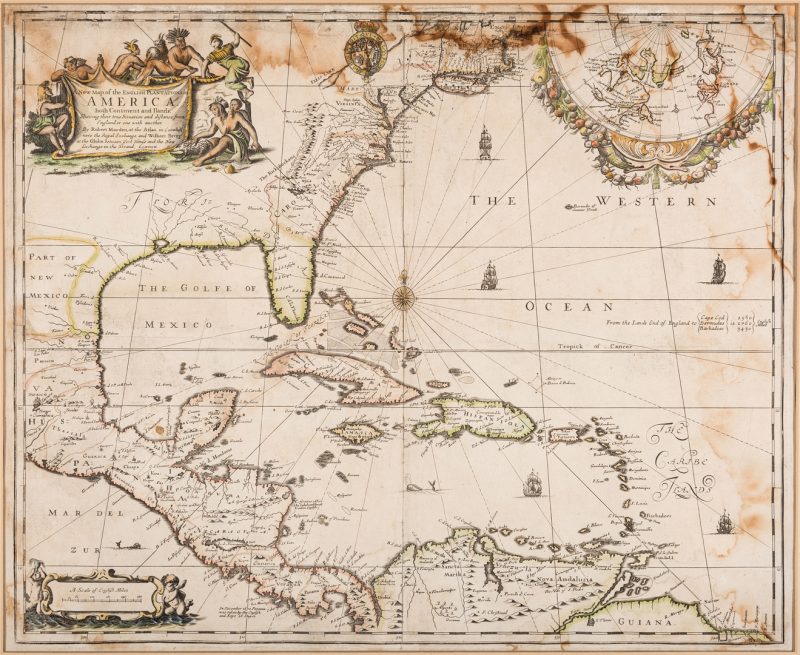 |
Morden 1673 Virginia Map of English Plantations |  Robert Morden (d. 1703) and William Berry (fl. 1669-1708) : A NEW MAP OF THE ENGLISH PLANTATIONS IN AMERICA BOTH CONTINENTS AND ISLANDS, “Shewing their true Situation and distance from England or one with another. By Robert Morden, at the Atlas, in Cornhill nere the Royal Exchange, and William Berry at the Globe between York House and the New Exchange in the Strand, London.” 1673, black and white line engraving with hand coloring on laid paper. Cartouche depicting Native American figures upper left; inset map upper right showing the true situation of the colonies in relation to Britain. 17″ x 20 3/4″ image; 17 1/2″ x 21 1/2″ sight, 28″ x 32″ frame. Ref. William C. Wooldridge, “Mapping Virginia,” fig. 74 p. 82-83; Wooldridge states that this rare map is “the first general map of the American colonies.” Private Middle Tennessee collection. CONDITION: 1″ x 1/4″ loss to upper right corner. Two 1/2″ x 1/4″ losses at center edge and upper left edge (filled in on backing paper). 1″ tear upper right edge. Dark staining to entire upper edge, extending along entire right edge of map, other scattered lighter stains and pale discolorations. Taped down along top. [See more photos →] |
$13,200.00 |
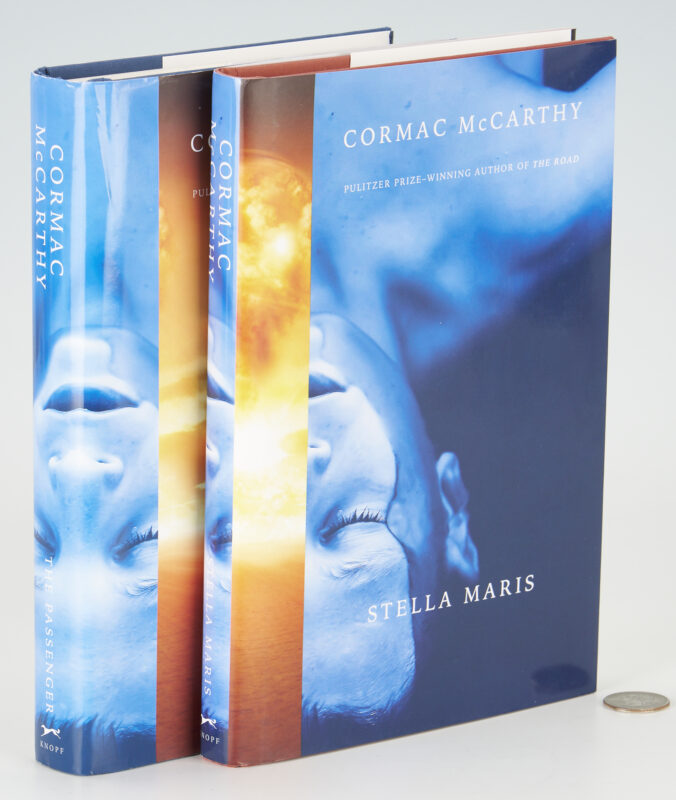 |
Cormac McCarthy, Signed 1st Editions, The Passenger plus Stella Maris |  1st Item: THE PASSENGER, Alfred A. Knopf, New York, 2022, 8 vo., First Edition stated with no additional printings. Presentation copy, warmly inscribed on the ffep (front free end paper) to McCarthy's long-time friend: "For Lanelle / My darlin / Tons of Love / Cormac". VG/VG, Very Good book in unread condition, in blue cloth boards with gilt stamping to spine, in VG unclipped jacket. 2nd Item: STELLA MARIS, Alfred A. Knopf, New York, 2022, 8 vo. First Edition stated with no additional printings. Presentation copy, signed on the ffep "Cormac McCarthy" and also warmly inscribed to McCarthy's long-time friend: "For Lanelle / Much love always / Cormac". F/F, Fine book in unread condition, in maroon boards with gilt stamping, in Fine unclipped jacket. Both books were published simultaneously (but STELLA being released a month after THE PASSENGER), both being offered together in a box set soon after. Note: Knopf also released a number of sets with McCarthy's signature on a tipped-in sheet; these are not that set, but a personalized pair. PROVENANCE: Collection of the original giftee, East Tennessee. CONDITION: 1st Item (Passenger): book has slight looseness, slight dent to top page block, DJ (dust jacket) has roughing to spine edges, cover has separate 1" wrinkles to top. 2nd Item (Stella): Very slight looseness, DJ with very slight roughing to spine edges. [See more photos →] |
$13,000.00 |
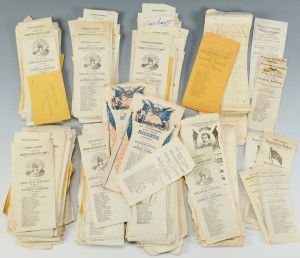 |
1864 Presidential Ballots, 730 Total |  Group of 730 ballots from the 1864 Presidential election, from Ohio soldiers voting in the field. The majority are Abraham Lincoln – Andrew Johnson Presidential ballots depicting Lady Liberty wielding a sword with a variety of other ballot designs and counties represented. A small minority (73) are McClellan – Pendleton Presidential ballots. Of the 73 McClellan – Pendleton ballots, there are 26 having portrait vignettes of McClellan. Several paper spacers with writing of locations soldiers stationed in the South are also present along with a few examples of handwritten ballots. Additionally, some of the ballots have the names of the soldiers written on the back with a few having phrases written on them. Examples include “L. S. Holcomb Co. D 97th Ohio”, who wrote: “can’t see peace at any price”. According to the 1886 History of Morgan Co. Ohio by Charles Robertson, Leroy S. Holcomb served in the Mission Ridge, Kenesaw Mountain, Atlanta, and Franklin, TN. Holcomb was seriously wounded at the Battle of Franklin later that year, and discharged. He subsequently studied medicine and graduated from the Ohio Medical College. Another soldier-signed ballot “Jas. R. Earich Co. E. 78 OVI” is for Sergeant James R. Earich of the 78th Ohio Company E. The Ohio History site states , “Earich took up the hazardous task of carrying a flag and fortunately survived the Battle of Atlanta. He was awarded a medal for bravery for his conduct on July 22, 1864. When Earich was offered a promotion to the rank of 2nd Lieutenant, he declined because he did not wish to give up bearing the colors.” Another ballot with the pencil inscription “H. N. Arnold Co. J 94th Ohio Vol Inf” is for H. Newton Arnold, 1st Lieutenant for the 94th Regiment of Ohio. Additional Lincoln/Johnson ballots include two (2) larger ballots with red, white, and blue and crossed flags, drums, swords, stacked rifles and winged eagle design, 3 ballots with the Union flag only, 13 ballots with no design on yellow paper from Morgan Co., and 10 handwritten Lincoln – Johnson ballots. Lincoln was victorious in winning the state of Ohio in the 1864 Presidential election. Condition: Overall very good condition. The two ballots with red, white, and blue colors have more folds and tears at the margin than others. Almost all ballots have a small hole in the center as a result of the tallying process, minor folds and tears at the margins, some toning. [See more photos →] |
$12,870.00 |
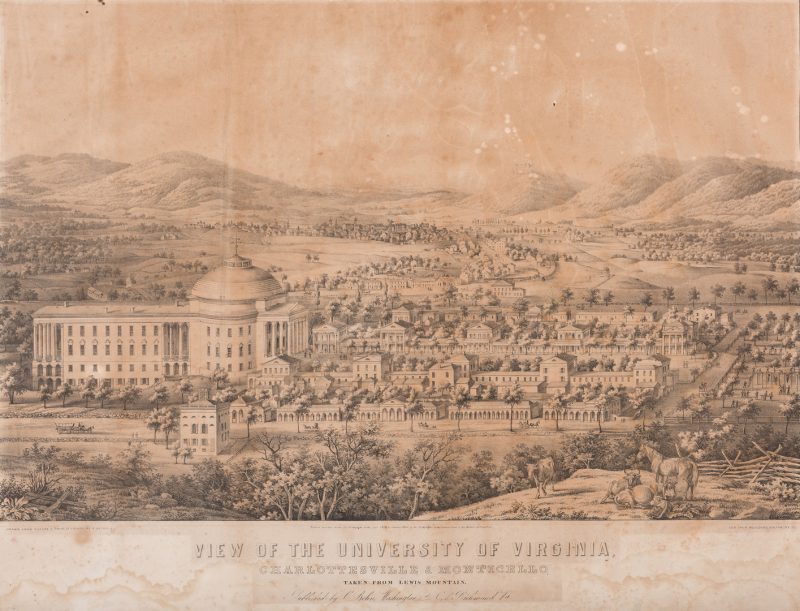 |
"View of the University of Virginia" Panoramic Map |  VIEW OF THE UNIVERSITY OF VIRGINIA, CHARLOTTESVILLE AND MONTICELLO, TAKEN FROM LEWIS MOUNTAIN, drawn and lithographed by Edward Sachse (Maryland/Germany, 1804-1873) and Company and the Sun Iron Building, published by Casimir Bohn (District of Columbia, mid 19th century), Washington, D.C. ; Richmond, V.A., 1856. Panoramic map depicting the Lawn of the original grounds of the University of Virginia, including the Annex to the Rotunda (constructed 1851-54, destroyed by fire in 1895), and the Anatomical Theater (completed in 1828, partially destroyed by fire in 1886, restored with modifications in 1888). The town of Charlottesville and Monticello Mountain are visible in the background. (Ref. “Virginia: Mapping the Old Dominion State Through History” by Vincent Virga and Emilee Hines, p. 44). Housed in a wooden frame. Sight – 20″ H x 26 1/4″ W. Framed – 26″ H x 33 3/4″ W. Provenance: The Estate of Charles Boyd Coleman, Jr., Chattanooga, TN, by descent from Lewis Minor Coleman, Jr., son of University of Virginia Professor and CSA Lt. Colonel Lewis M. Coleman (1827-1863) and Mary Ambler Marshall (daughter of James K. Marshall and granddaughter of John Marshall (1755-1835)). Lewis M. Coleman Jr. was also related to the family of Henry Dearborn by his marriage to Julia Wingate Boyd, daughter of Annette Maria Dearborn Boyd, who was the daughter of Greenleaf Dearborn (1786-1846) and great granddaughter of Gen. Henry Dearborn (1751-1829) on her mother’s side. Biography: “Coleman, Lewis Minor, born in Hanover County, Virginia, February 3, 1827; graduated with high honors at the University of Virginia, in 1846, and became principal of the Hanover Academy; in 1859, upon the resignation of Dr. Harrison from the chair of ancient languages in the University of Virginia, Mr. Coleman, who had been a pupil of Dr. Harrison, was elected professor of Latin, and relinquished his position in the Hanover Academy to accept the same; he served in that capacity but for two years, for in 1861, at the outbreak of the civil war, he joined the ranks of the Confederate army, in which he enlisted as captain of an artillery company which he recruited; he was promoted to the rank of lieutenant colonel of artillery in 1862; at the battle of Fredericksburg, December 13, 1862, he was severely wounded, and after three months died from his injury, March 21, 1863”. (Source: “The Encyclopedia of Virginia Biography:, Volume III, by Lyon Gardiner Tyler, LL. D., 1915). CONDITION: Overall fair condition with toning, moderate dampstaining, and foxing spots. Areas of acid burn, largest 1/4″, top right quadrant of sheet. 3″ L. horizontal tear, center left edge of sheet. 3/4” L. loss to sheet and small dark stain at top, left of center. [See more photos →] |
$11,264.00 |
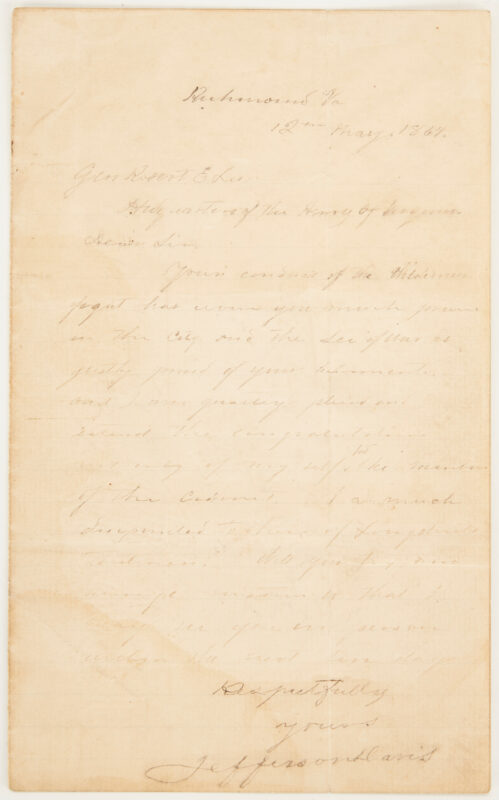 |
Civil War Jefferson Davis Signed Letter to Robert E. Lee, May 1864 |  Civil War era ALS. One-page bifolium handwritten autographed letter signed by Jefferson Finis Davis (1808-1889) as president of the Confederate States of America (CSA) from 1861 to 1865, Richmond, Virginia, writing to General Robert Edward Lee (1807-1870), Headquarters of the Army of Virginia, dated May 12, 1864. Composed shortly after the events of the Battle of the Wilderness (fought on May 5-7, 1864), Davis writes "Your conduct of the Wilderness fight has won you much praise in the City [of Richmond] and the Sec[retary] of War [James Seddon] is justly proud of your achievement and I am greatly pleased and extend the congratulations not only of myself but the members of the Cabinet. I am much disappointed to learn of [Lieutenant General James] Longstreet's tardiness. Will you try to arrange matters so that I might see you in person within the next ten days. Respectfully yours, Jefferson Davis." Does not include envelope, typed transcription is included. Letter: 8 1/8" H x 10" W. PROVENANCE: By descent from the estate of Stanley Horn, Nashville, Tennessee. CONDITION: Writing and signature are in overall good, legible condition with fading, particularly toward the end of the letter. Fold lines with very minute tears towards the edges. General handling wear, areas of dampstaining, largest 5 3/4" x 6" (partially affects signature). Minute area of stick residue to lower left and right, interior of bifolium. [See more photos →] |
$11,250.00 |
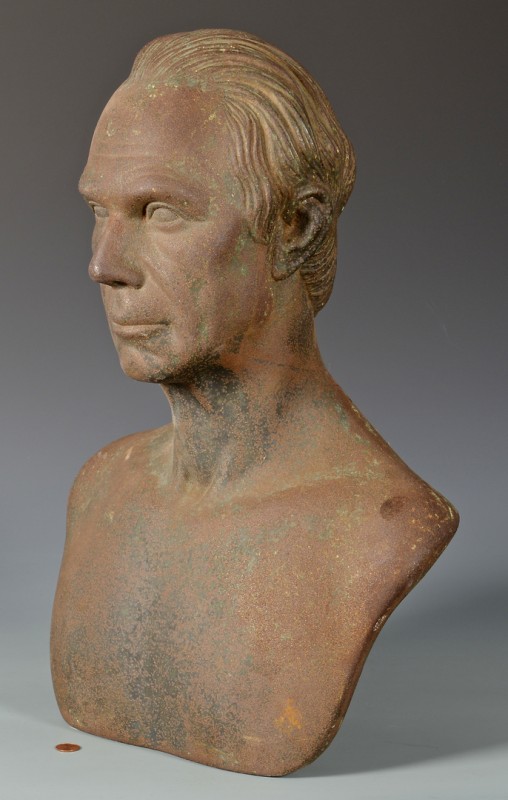 |
Ferdinand Pettrich, Bust of Henry Clay |  Bust of Kentucky statesman Henry Clay (1777-1852) by Ferdinand Pettrich (German/American, 1798-1872). Life-sized cast-iron bust, plate verso with the name of sculptor and date of 1842 (the year Clay retired from the U.S. Senate and returned home to Kentucky; in 1844, Clay was nominated as the Whig party Presidential candidate). 22″H x 15″W. Biography: German-born Ferdinand Pettrich trained in the studio of his father in Dresden, before traveling to Rome to study under the famous Danish sculptor Thorwaldsen. He came to America, where he spent considerable time in Washington D.C. from 1835-1843 seeking commissions for his work. Many of his subjects were American politicians of the day. Pettrich resided in Georgetown with his wife and three children and rented a studio in an abandoned church. In an 1838 letter of a patron of Pettrich, the sculptor appealed for help because of the illness of one of his children. The patron stated Pettrich had requested Henry Clay sit for a bust and Clay had responded with a favorable reply (p. 398 Ferdinand Pettrich in America by R. L. Stehle). Some of Pettrich’s notable sculpture commissions included “Washington Resigning His Commission” and “Dying Tecumseh”. He also executed busts of Martin Van Buren and Andrew Jackson. In May of 1842, two assassins entered Pettrich’s studio and stabbed him twice. Shortly thereafter, Pettrich and his family moved to Brazil and he became the court sculptor for Emperor Dom Pedro II, carving monumental sculptures of the monarch and his cabinet officials before returning to Europe. Note: A similar plaster bust is featured in the book “Franz and Ferdinand Pettrich: Two Saxon Sculptors from the Period of Classicism” by Hans Geller, Dresden: Wolfgang Jess, 1955, see page 128, image #66. Provenance – Lexington, Kentucky area collection. Condition: Overall oxidation and light pitting as the much of the original bronzed surface has been lost. CONDITION: Overall oxidation and light pitting as much of the original bronzed surface has been lost. [See more photos →] |
$10,836.00 |
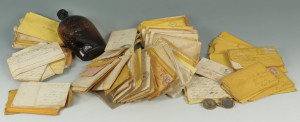 |
Capt. Oliver Pinkney McCammon Civil War Archive |  A freshly discovered and extensive Civil War archive relating to Captain Oliver Pinkney McCammon (O.P.M.) of the 3rd East Tennessee Cavalry, Company L, also relating to the explosion of The Sultana and campaigns in Tennessee. Over 120 items, mostly letters of correspondence between Captain Pinkney (1840-1897, Blount Co.,TN) and his future wife, A. E. McCall of Blount Co., during the war years of 1861-1865. Archive also contains additional letters of correspondence between Captain Pinkney and his father, the men in his regiment, and others. This lot also contains a small circular tintype of McCammon in uniform and an amber “Union” bottle from the war period. An overview of content includes McCammon’s discussion of military campaigns in Middle Tennessee including engagements with General Wheeler and Hood, capture of his regiment by General Forest in September of 1864 and his subsequent escape, correspondence relating to the loss of several of his men on the ill-fated Sultana steamboat, discussion of guerilla attacks by Rebels in East Tennessee by A. E. McCall and his father, discussion of local and national political matters, smallpox breakouts in the camps, and an ongoing written courtship between McCammon and his future wife, Ann E. McCall. The archive contains letters such as the poignant correspondence written Nov. 20, 1864 from Susan Fowler to Captain McCammon on the report her son, Andrew Fowler, who was taken prisoner by the Confederates. She writes, ìit is a consolation to know that he (Andrew) is not numbered with the dead. I hope the time will soon come for him to return under your command as Andrew is all the support I have his father having died since he went away and left me with four children to take of. I hope God will spare him to be an honor to his country & a blessing to meÖî (note ñ an A. Fowler from the 3rd Tennessee Cavalry is listed as killed on the Sultana in April 1865). An earlier January 1863 letter from Captain McCammon reviews the remaining carnage of the Shiloh battlefield over 7 months later, ìwe stopped at Cornith overnight. Near the long to be remembered Battle Ground of Shiloh, which place still bears witness of the vanity of life. Fragments of garments and the skeletons of the dashing cavalry horses are not all the marks yet remaining of warís wild rage, for human skulls are by no means scarce, upon the surface…î An excerpt from a Nov. 1864 written by Capt. McCammon discusses the capture of men in his regiment, ìIt turns out that Joshua Hines is not dead but is a prisoner in the Rebelís hands, so says a Report brought through by the Sutler of our RegtÖ Our Boys are at Cahaba, Ala & were in tolerably good health. When he left though living upon very scanty rations. Well, we have about one hundred and twenty five men here as the representatives of eleven companies & I believe my own Company came though best of any, having thirty five me including a few that were not captured, & those who were and have since made their escape. (Note ñ A. J. Hines from the regiment is later listed as killed on the Sultana). A later letter May 1865 McCammon writes, ìThe last few days have been truly days of anxiety with us–in relation to the boys of our Regiment who had been in Rebel Prison, — whom it seems were aboard–(The Steamer Sultana) –at the time of the explosion the number of our boys rescued from the sad condition into which they were thrown by the occurrence of the disaster, amounts to about one hundred and forty among which I noticed the names of Bart McMurray, Sam Pickens, Van Headrick, Pat Ray, Wm Hill, James Baker and two of the Pryor Boys.—I believe this includes the Majority of those saved that you would likely know.— Alexander McCammon died on a boat near St. Louis, Mo. Sometime previous to the above mentioned accident…î McCammons future wife, Ann McCall writes him from East Tennessee in November of 1864, ìì…things appear somewhat in a bad fix tho I hope it will not be in as bad a fix as some think it is, it is true that some of them is in bad fix they have had to leave home to go into the Southern Army their was only fifteen passed here to day in some company some from Jeferson and some from Blount and how many more is runing I canít tell. General Gillam had a fight at the Gap and got his forse scattered and they are runing everwhere their was three of them here this evening hunting their way to Knoxville. It is reported that they have been fighting at Strawberry Plains yesterday. I canít tell how true it is I recon Naughn A Brachinridge is up their some plase from the account that some of them gives that has run from up their some of them say that they havenít slept in their oun house for four months. What this country is going to turn to I canít tell they get worse ever day their is a farsed? that bellong to no army they just go about and ___ peopleís houses and steal anything they want…î Correspondence from a cousin of Ann McCall in February of 1864, ìit looks like the rebs and negros will take this plase after while the rebs is coming in daly and joining our regiment som of them think will do while others wont. Blont (Blount) Co. is very well represented(sp?)Öwe hear now our forces hav fel back to Noxville and Marville . I donít like that if we can hold thare a monthÖî Captain McCammon writes in September 1863, ìI should have been much pleased to enter my own County seat (Blount Co., TN) with the first Blue Coats, but as we are under the command of Rosecrans & it fell to the Col. of Burnsides to possess that country with federal forces, we have been deprived of that pleasure. To get revenge the boys went guerrilla hunting the other data & brought in twelve of the thieving scoundrels who were prowling about recruiting some thirty miles from here. ì A January 1865 letter from Captain McCammon near Nashville discusses the state of the Confederate cause – ìThe Rebel Army, of the West, utterly demoralized, disorganized, & almost Panic Stricken. General Sherman has Marched Victoriously through Georgia & Captured enough of Rebel property in Savannah to pay the entire expense of the campaign, – Whilst the Army of the East holds Lee at the gates of Richmond as a Sentinel giving but little time to contemplate any aggressive act whatever.î In addition to the letters, the majority retain the original envelopes and postmarks, a handful of other letters from friends and family members are post 1865. Provenance: Consignor is a direct descendant of McCammon; descended in his family. Condition: Expected toning and discoloration, few with minor edge losses, but all letters readable and in generally good condition. [See more photos →] |
$10,440.00 |
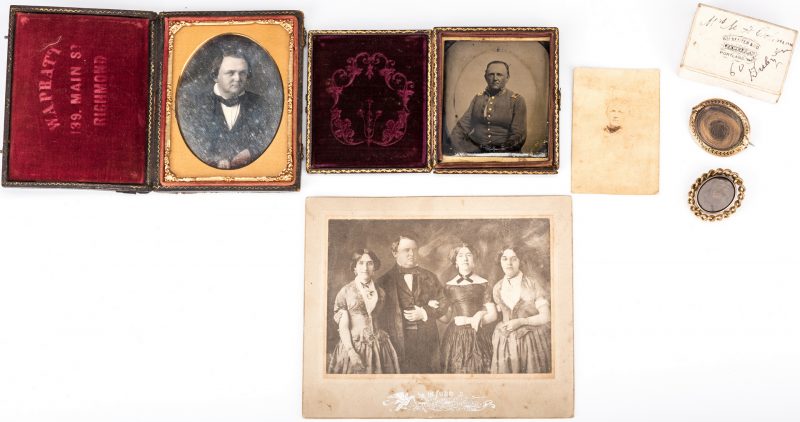 |
Lewis M. Coleman Photographic & Memorial Archive |  Lewis Minor Coleman (Virginia, 1827-1863) photographic and memorial archive. 1st item: Sixth-plate tintype of Lewis Minor Coleman attired in his CSA uniform. Housed in a tooled leather case, 1/2″ x 3 3/4″ x 3 1/4″. 2nd item: Cabinet card photo by A.W. Judd (1846-1929), Chattanooga, Tennessee depicting Lewis Minor Coleman accompanied by two aunts and another female family member. 5 1/2″ H x 6 3/4″ W. 3rd item: W. A. Pratt, Richmond, VA quarter-plate daguerreotype of Lewis Minor Coleman housed in a tooled leather case, 1/2″ x 4 3/4″ x 3 3/4″. 4th item: G. W. Minnis, Richmond, VA cabinet card of Lewis Minor Coleman attired in his CSA uniform, inscribed en verso, Lewis Minor Coleman I, Lt. Col. 1st Va. Artillery, C. S. A., 3 1/4″ x 2 1/4″. 5th item: Victorian oval gold plated mourning/memorial brooch, laurel and oak leaf detail, with inscription en verso reading “LMC died March 21st, 1863″, 1 1/4″ x 1 3/8″. 6th item: Victorian oval gold plated swivel double sided mourning/memorial brooch with swirl rope frame, not engraved but belonging to Lewis Minor Coleman, 1 1/2″ x 1 1/4”. Provenance: The Estate of Charles Boyd Coleman, Jr., Chattanooga, TN. Descended in the family of Lewis Minor Coleman, Jr., son of CSA Lt. Colonel Lewis Minor Coleman (1827-1863) and Mary Ambler Marshall, daughter of James K. Marshall and granddaughter of John Marshall (1755-1835). Lewis M. Coleman Jr. was related to the family of Henry Dearborn by his marriage to Julia Wingate Boyd, daughter of Annette Maria Dearborn Boyd, who was the daughter of Greenleaf Dearborn (1786-1846) and great granddaughter of Henry Dearborn (1751-1829) on her mother’s side. Biography: “Coleman, Lewis Minor, born in Hanover county, Virginia, February 3, 1827; graduated with high honors at the University of Virginia in 1846, and became principal of the Hanover Academy; in 1859, upon the resignation of Dr. Harrison from the chair of ancient languages in the University of Virginia, Mr. Coleman, who had been a pupil of Dr. Harrison, was elected professor of Latin, and relinquished his position in the Hanover Academy to accept the same; he served in that capacity but for two years, for in 1861, at the outbreak of the civil war, he joined the ranks of the Confederate army, in which he enlisted as captain of an artillery company which he recruited; he was promoted to the rank of lieutenant colonel of artillery in 1862; at the battle of Fredericksburg, December 13, 1862, he was severely wounded, and after three months died from his injury, March 21, 1863”. (Information according to Encyclopedia of Virginia Biography, Volume III, By: Lyon Gardiner Tyler, LL. D., Lewis Historical Publishing Company, New York 1915). See other lots related to this family in this auction. CONDITION: 1st item: Tintype not mounted into case, case split in half, general wear. 2nd item: Overall toning. 3rd item: Wear to case, image very good condition. 4th item: Fading, toning and wear to image. 5th & 6th items: Overall very good condition with minor wear. [See more photos →] |
$10,240.00 |
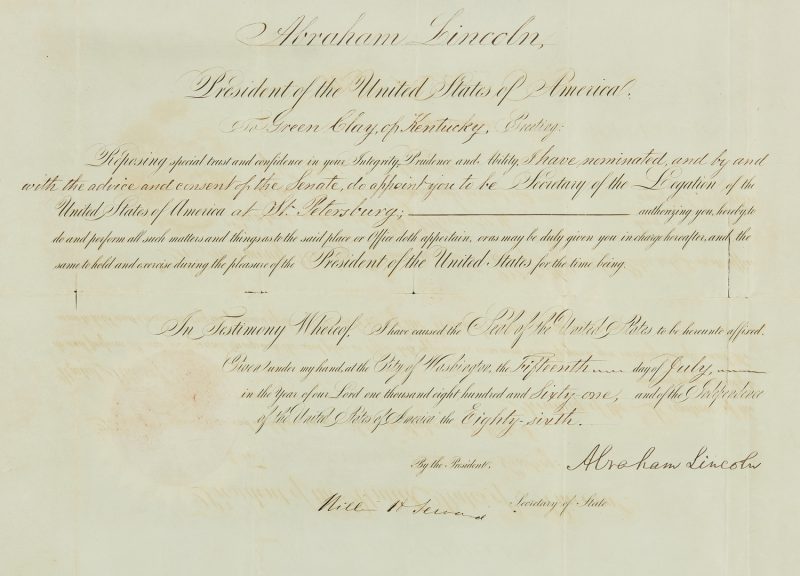 |
Abraham Lincoln signed 1861 Appointment, Green Clay of KY |  Signed Abraham Lincoln Civil War era document appointing Green Clay of Kentucky (1839-1912) as Secretary of the Legation of the United States at St. Petersburg, Russia, July 15, 1861. Signed by President Abraham Lincoln and countersigned by Secretary of State William Seward. Embossed presidential seal lower left. 12" x 18" sight, framed under glass in later narrow black metal frame, 12 1/4" x 18 1/4". Col. Green Clay was a member of Bourbon, County Kentucky's prominent Clay family. He was the son of Brutus Junius Clay and grandson of General Green Clay. He attended Transylvania University in Lexington, KY, and Yale University. He was a recent graduate of Harvard Law School in 1861, when his fellow Kentucky native, President Abraham Lincoln, appointed him Secretary to the United States Minister to Russia. That post was held by Clay's uncle, the Honorable Cassius Marcellus Clay, a noted abolitionist. Green Clay worked only one year in Russia, helping his uncle secure Russian support for the Union cause before returning to the US to fight in the Civil War. He served as a Colonel in the Union Army, 3rd Kentucky Cavalry from 1862 to 1865. CONDITION: Lincoln autograph clear and bold, crossed by two fold lines. Some separations along fold lines, overall toning, scattered creasing. 1 3/4" tear lower left edge. [See more photos →] |
$9,600.00 |
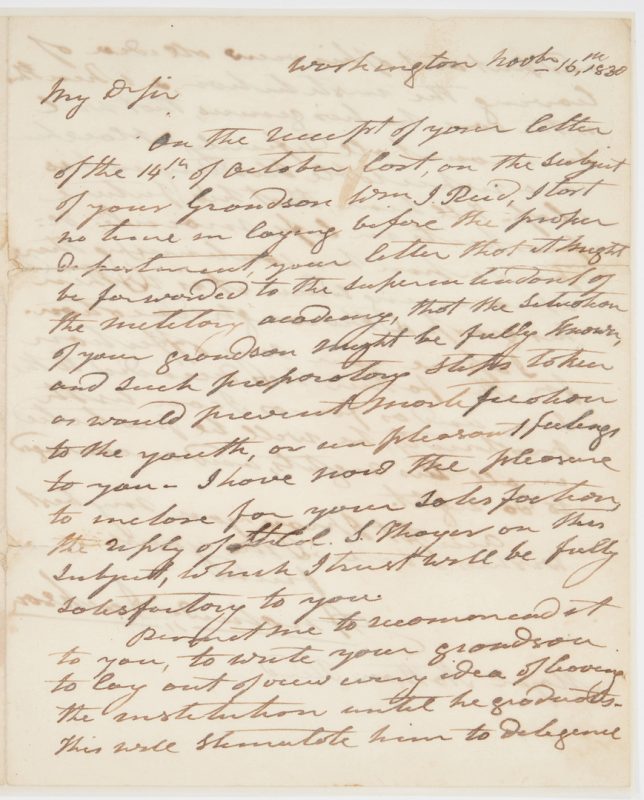 |
Andrew Jackson ALS, 1830 |  Andrew Jackson (1767-1845) autograph letter, signed, as President (1829-1837), to Major Nathan Reid of New London, Virginia, detailing Jacksonâs intervention with Lt. Col. (Sylvanus) Thayer of West Point on behalf of Reid's grandson, William Steptoe Reid (roommate of future author Edgar Allan Poe), and encouraging the younger Reid to embrace and continue his education there. One page folio letter on vellum, Washington, November 16, 1830. 10" H x 16" W. Note: Major Nathan Reid's son (and William Steptoe Reid's father), Major John Reid, was Jackson's aide de camp during the War of 1812 and did not survive the conflict. Nathan Reid helped raise his grandson, while his friend Jackson, who lost his own father at a young age, became an uncle-like figure to young William. According to a privately published family history, it was Jackson who persuaded William to enter West Point although William wanted to be a doctor. While at West Point, William Steptoe Reid roomed with Edgar Allan Poe (who soon grew disillusioned with military school himself, and whose exploits ultimately resulted in explusion). Although Andrew Jackson himself rose to become one of the most prominent generals in American history, he lacked a formal military education, making his efforts to ensure a successful career at West Point for young William all the more meaningful. Ultimately, even presidential pressure was not enough to keep Steptoe in military school. He left West Point in March of 1831, the same year as Poe. William entered the Medical School of the University of Pennsylvania, and became a prominent doctor in Holly Springs, MS and later Middle Tennessee, where he married Sarah Claiborne Maury. Dr. William Steptoe Reid's medical bag and a photographic portrait, which, like this letter, have descended in his family to the current consignor, are also being offered in this auction. Transcription of letter: "My Dr Sir, On the receipt of your letter of the 14th. of October last, on the subject of your Grandson Wm. J. Reid, I lost no time in laying before the proper department, your letter that it might be forwarded to the superintendent of the military academy, that the situation of your grandson might be fully known, and such preparatory steps taken as would prevent mortification to the youth, or unpleasant feelings to you. I have now the pleasure to inclose for your satisfaction, the reply of Lt Col. S. Thayer on this subject, which I trust will be fully satisfactory to you. Permit me to recommend it to you, to write your grandson to lay out of view every idea of leaving the institution until he graduates. This will stimulate him to diligence and put out of his view all idea of leaving the institution, & when this is the case, he has genius, that will surmount all difficulty, & place him in a respectable standing in his class. Tell him that his future prospects in life mainly depend upon his continuing there & procuring when it is within his grasp, a thorough education. I assure you my affection for the father has descended to the son, and as far as I can with propriety, he will be protected in all his rights, and encouraged to do right. Accept I pray you my best wishes & believe me your friend, Andrew Jackson." CONDITION: Letter was professionally conserved by Christine Young and enclosed in japon paper to address some separations and small losses at fold lines and scattered foxing. Small stain still evident on page 2 between "Nathan" and "Reid." Signature bold and clear, untouched by fold lines. [See more photos →] |
$9,000.00 |
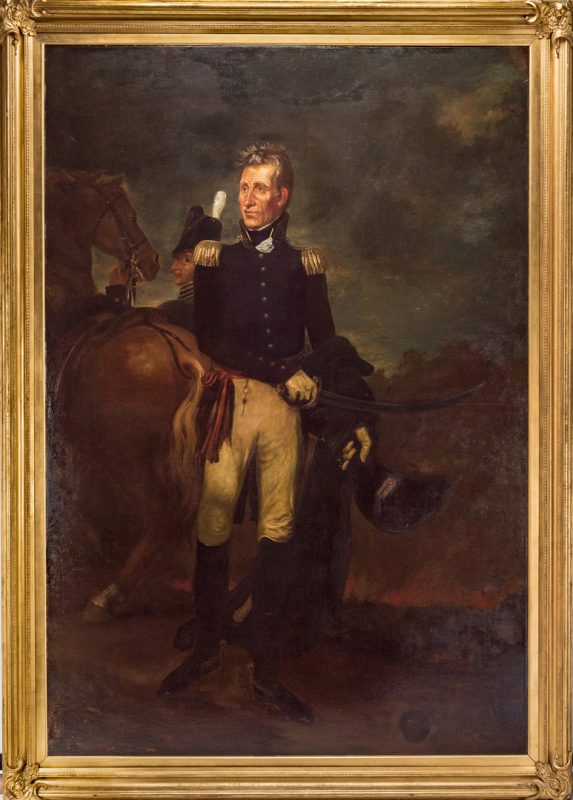 |
Andrew Jackson Portrait attrib. Leutze |  Large oil on canvas historical portrait of President Andrew Jackson (1767-1845), after the 1820 full-length portrait by John Vanderlyn. Attributed to historical genre painter Emanuel Gottlieb Leutze (District Of Columbia/New York/Germany, 1816-1868). This life sized painting depicts Jackson on the battlefield (likely at New Orleans), attired in his military dress uniform, holding his sword in one hand and hat in the other, with his horse and fellow soldiers in the background. Housed in a carved cove style gilt wood frame with applied corner elements. Sight – 94 3/4″ H x 64 1/2″ W. Framed – 106 1/2″ H x 76 1/2″ W. Provenance: private Tennessee collection, acquired at Freeman’s Auction, Philadelphia, Nov. 13, 2013 Lot 267; Private Pennsylvania collection, acquired at Freeman’s Auction, April 12, 2003, Lot 196; The Free Library of Philadelphia, where it hung for many years in Pepper Hall at the Central Branch; given to the Library March 2, 1931, by John Frederick Lewis, who acquired the portrait from the estate of Almira K. Schwenk. This painting came to the library with the tradition that it had been exhibited at the Centennial Exposition in 1876, although we have not been able to confirm this. CONDITION: Canvas laid down on masonite, rubbing to left perimeter edge of canvas, numerous old repairs. Blacklight reveals area of flourescence to several areas of background and to cheek, pant leg. [See more photos →] |
$9,000.00 |
 |
Kentucky Confederate Call to Arms Broadside, 1862 |  KENTUCKIANS TO ARMS! broadside, issued by Captain W. W. Cleaver, 6th Regiment, Kentucky Cavalry, Company F, from the headquarters for the Confederate Army in Lebanon, KY, dated September 12, 1862, reading "I am authorized by the Confederate Government to raise a Company of Cavalry for the Southern Army, to serve three years or during the war, and I call upon Kentuckians to…drive out Lincoln's abolition minions of the North…and to-day the Abolition Army is skulking behind the walls of Washington, in full view of the victorious Southern Army. Horse, arms and full equipments furnished to all who chose to volunteer. W. W. Cleaver." Housed under glass in a wooden frame. Broadside: 11" H x 11 1/8" W. Framed: 16 1/2" H x 18 1/2" W. CONDITION: Overall good, legible condition with some fading to lettering, foxing spots, areas of damp staining, largest 1 1/2" x 5 1/4", tears, largest 3/4" and areas of loss, largest 1/4", to center fold line. Broadside is loose, not adhered to board. [See more photos →] |
$8,960.00 |
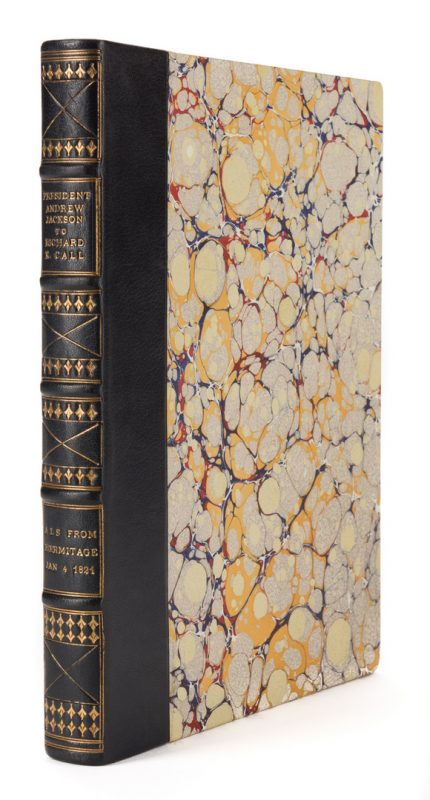 |
Early Andrew Jackson Signed Letter to Richard K. Call (ALS) |  Early Andrew Jackson signed letter to Richard K. Call (ALS), protege and former military aide to Jackson during the War of 1812, later Governor of Florida Territory. Written from The Hermitage, Tennessee, dated January 4, 1821, prior to Jackson’s appointment as Military Governor of Florida and election as President, two and one half-page letter signed Andrew Jackson, lower right of second page, with postscript initialed A. J., middle right of third page. The letter refers primarily to Call’s romantic relationship with his future wife Mary Letitia Kirkman, Nashville, TN, despite the fact that her parents were enemies of Jackson and deeply opposed the union. The postscript refers to Jackson’s approval of John C. Calhoun’s, Secretary of War, proposal for what would become the Reduction Act, passed by Congress March 2, 1821, as well as his opinions on the Missouri Compromise controversy, stating “The house of Representatives has rejected Misouri [sic], the Senate has admitted it, [John Henry] Eaton, (United States Senator from Tennessee and friend of Jackson’s), has done himself musch credit by an amendment which is said produced the admission by the Senate Should the house reconsider its vote Misouri [sic] will I expect sequester the property of the U.S. and hold it for their own use, untill [sic] it is invited into the Union by Congress, this is the only course she can adopt as an independant [sic] State, unless she returns to her Teritorial [sic] government, this would be a course too humble for a free people to submit to…”. Includes typed transcription of letter. Also includes a stipple engraving of Andrew Jackson by Henry Bryan Hall after a portrait by Ralph Eleaser Whiteside Earl (American, c. 1785/88-1838). Letter, transcription, and engraving housed in an archival letter box with marbled paper boards, black leather half-binding with gilt title lettering and five raised hubs on spine. Letter – 9 7/8″ H x 8″ W. Transcription – 11″ H x 8 1/2″ W. Engraving – 8 5/8″ H x 5 3/4″ W. Archival Box – 11 3/4″ H x 9 1/2″ W x 1 1/8″ D. American. Provenance: Anne P. and Thomas A. Gray Library and MESDA Research Center. CONDITION: Letter in overall very good condition. Five brown stains, largest 3/4″, right vertical crease of letter. Few minute holes, surface of last page. Right and left vertical creases have been professionally repaired (very inconspicous). Areas of light overall toning surrounding image, surface of engraving. Toning visible en verso, engraving. [See more photos →] |
$8,960.00 |
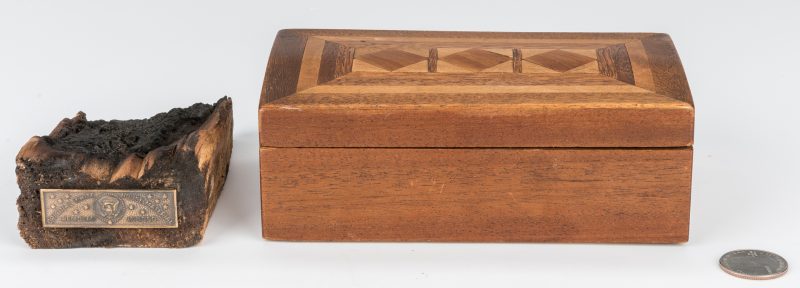 |
War of 1812 White House Artifact & Custom Box |  Remnant of a burned White House timber removed from the White House during the 1950 renovations, from the 1814 White House fire started by the British during the War of 1812. Bears plaque to side reading “Original White House Material/ Removed in 1950″ with the Presidential Seal in the center. Housed in a custom made marquetry box comprised of walnut and oak from White House repairs and cedar from the White House grounds. Construction diagram pasted to the interior of the lid and signed by the maker F. C. Mayes. Wood artifact – 4 1/2″ x 2 1/2”. 2″ H x 6″ W x 3 3/4″ D. Note: From 1949 to 1952, the White House underwent a major renovation. President Harry Truman noticed when he moved in that the White House was quite dilapidated, and pressed Congress for funds to refurbish the mansion. In the House of Representatives, the White House renovation was overseen by the Public Works Committee, on which sat first-term Congressman Gerald Ford. Truman gave Ford and other committee members a personal tour of the White House, pointing out its defects. What Ford remembered most, however, “was when he took us into the Oval Office and I saw that little sign on his desk: ‘The Buck Stops Here’. I thought, Well, that’s a good description of a President’s job”. The three-year project included tearing down all but the exterior walls and rebuilding everything within. In the process, workers found charred lumber from the burning of the White House in 1814. Clearly these structurally unstable pieces could not remain. Instead, they were removed and sold to the public as souvenirs, as directed by the Commission on the Renovation of the Executive Mansion. In March of 1952, a small ceremony marked the end of the renovation and the opening of the refurbished and structurally-sound White House. Provenance: From the estate of Captain Gordon Wells, member of the Secret Service’s Uniformed Division, the White House Police, from 1943 through 1967. During his tenure, Wells received mementos from sitting Presidents and First ladies of 5 administrations, from Franklin Roosevelt through Lyndon B. Johnson. CONDITION: Both artifacts in very good condition. [See more photos →] |
$8,960.00 |
 |
Cameo brooch of Randal McGavock by Saulini 1851 |  Important cameo brooch portrait of Confederate Colonel Randal McGavock, former mayor of Nashville, killed in the Civil War at the Battle of Raymond, Mississippi in 1863. Randal McGavock references in his journals having this cameo made in Rome (“Pen and Sword, the Life and Journals of Randal McGavock” by Herschel Gower). Randal quotes in his journal, “My cameo came in today and I think the artist has succeeded admirably in getting a good likeness.” The cameo is signed in the lower right corner “Saulini F. Roma 1851.” Gold setting tested as 18K. Total weight 23.1 grams. Attributed to the Saulini workshop in Rome. Tommaso Saulini (Italian, 1793-1864) and Luigi Saulini (1819-1883) were master cameo carvers from this workshop established in 1836. Tommaso was a renowned specialist in portraiture, both in hardstone and shell who produced sculptural engravings from his workshop in Via del Babuino in Rome. His son Luigi (1819-1883) engraved the portraits of Queen Victoria and Prince Albert and won a medal at the 1862 International Exhibition in London. Excellent condition with slight discoloration to area near ear. 2 3/8″ x 2″. Circa 1851. Lindsley Warden estate.
|
$8,730.00 |
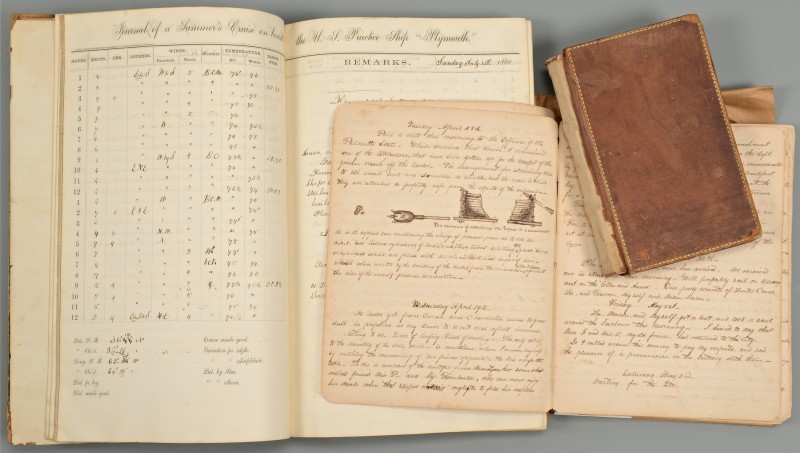 |
Confederate Navy Archive of Lt. Dabney Scales in Europe & Other |  Civil War archive of Confederate Navy Lieutenant Dabney Scales including an 1863 journal detailing Dabney Scales assignment in Europe (approx. 250 pages), Scale’s 1860 U.S. Practice Ship “Plymouth” log journal (188 pages), and a Scales family post-War accounting journal spanning from 1871-1882 in Memphis, TN. Biography of Dabney Scales – Dabney Minor Scales (1841-1920) of Memphis, TN was the son of Peter Scales, a planter from Virginia. Dabney attended the US Naval Academy and joined the Confederate Navy at the outbreak of the Civil War. He served on the CSS Savannah, CSS Capital, CSS Arkansas, CSS Atlanta, and the CSS Shenandoah. In 1863-4, Scales was assigned to Europe and spent time in London and Paris regarding the outfitting and manning of Confederate ships constructed in England. After the Civil War, Dabney Scales lived in Mexico a short period before returning to Memphis to practice law. Dabney was elected to the Tennessee legislature and served in the Tennessee State Senate. In the Spanish-American War, he served as a lieutenant during the conflict. 1st item – 1863 journal detailing Dabney Scales’s assignment in Europe (approx. 250 pages) beginning April 24th, 1863 on Iron Clad “Atlanta off Fort Jackson near Savannah, GA and concludes on March 26, 1864 in Paris, France. Highlights from this extensive diary include running the blockade of Charleston on the steamer, “Ella and Anna”. Scales writes of their voyage to Nassau, Havana, St. Thomas, and finally to Southhampton, England. Upon arriving in Paris with fellow officers of the Confederate Navy, he reviews his days “sight seeing” in the Paris environs while also commenting on the war news from home. There is considerable discussion about the CSS Florida at Brest and Scales has communications with some of the Florida officers by person or written correspondence through other shipmates. 2nd item – Dabney Scale’s 1860 U.S. Practice Ship “Plymouth” log journal (188 pages) from his period at the Naval Academy in Annapolis, June 25, 1860 to Setember 26, 1860. CONDITION: 1st item – covers lost, most of binding lost with several of the first 30 pages separated from binding. All very legible. 2nd item – Spine with losses, minor wear commensurate with age. 3rd item – post war accounting journal with losses to spine. [See more photos →] |
$8,496.00 |
 |
1871 Foster Map of Davidson County |  Large, early and scarce map of Davidson County – NASHVILLE, TENNESSEE, FROM ACTUAL SURVEYS MADE BY ORDER OF THE COUNTY COURT OF DAVIDSON COUNTY, 1871 surveyed and mapped by Wilbur F. Foster, Civil and Topographical Engineer; Engraved, printed and manufactured by G.W. and C. B. Colton of New York. Depicts different colored civil districts along with roads, railroads, streams, schools and businesses, post offices, and some residences with owner names. Pictorial view of the city of Nashville from the west including image of the State Capitol building, at lower margin. 54″ x 49″ sight, 55 1/4″ x 50 1/2″ in stained hardwood frame. Provenance: the estate of Sarah Hunter Hicks Green, formerly of Historic Devon Farm, Nashville, Tennessee. CONDITION: Multiple tape-repaired tears, scattered holes up to 2″ diameter, many creases, appears lacquered. [See more photos →] |
$8,260.00 |
 |
Presidential/Civil War Autograph Albums plus Henry Longfellow Letter |  Two (2) autograph albums from the early Nineteenth Century to the Civil War, containing the signatures of Presidents and First Ladies, prominent Civil War figures, notable authors, and other important Americans. Approximately fifty-six (56) autographs are inscribed directly onto the pages, pasted to paper, or on loose paper, with a few images, drawn onto the paper and loose. Presidents and First Ladies: Two (2) JOHN ADAMS (1735-1826) clipped signatures pasted to page with Abigail Adams and Charles Francis Adams Sr. signatures (see below). Includes one (1) end of life signature with additional piece of paper with location and date reading “Quincy April 28th 1823” pasted below signature, located in blue album. One (1) ABIGAIL ADAMS (1744-1818), wife of John Adams, clipped signature pasted to page with John Adams and Charles Francis Adams Sr. signatures (see above), with additional piece of paper dated “1813” pasted below signature, located in blue album. Two (2) JOHN QUINCY ADAMS (1767-1848) clipped signatures. One (1) pasted to lower right corner of page with Louisa Catherine Adams autographed poem (see below), located in blue album. One (1) pasted to page with Samuel Adams and Charles Francis Adams Sr. signatures (see above), located in brown album. One (1) LOUISA CATHERINE ADAMS (1775-1852), wife of John Quincy Adams, one-page autographed poem written on the page, dated August 11, 1848 from Quincy, MA, reading “Yet let not hence, presumption dare to scan The scope and purposes of Almighty mind Or scrutinize with impious doubt the plan Of wisdom and of goodness still combinedÖ”. Includes a small engraved portrait of John Quincy Adams with his clipped signature pasted to the page (see above) with a notation in Louisaís hand indicating that the poem was written by John Quincy Adams, located in blue album. One (1) JAMES BUCHANAN (1791-1868) clipped signature pasted to page, dated April 25, 1845, located in blue album. One (1) JAMES MADISON (1751-1836) free franked panel pasted to page, dated February 19 [year unspecified], from Washington, D.C., addressed to Richard Cutts, his brother-in-law, located in blue album. One (1) DOROTHEA DANDRIDGE PAYNE TODD MADISON (1768-1849), also known as DOLLEY MADISON, wife of James Madison, one-page autographed quotation written on page, dated June 1, 1848 from Washington, D.C., reading “Temper, thy power more magical Than that which graced of old Amphion’s lyre, Can savage hearts with wondrous spell the mind enthrall Can clean suspicion’s mist with gladdening fire…”, located in blue album. One (1) JAMES K. POLK (1795-1849) clipped signature pasted to page, undated, located in blue album. Authors: One (1) WASHINGTON IRVING (1783-1859) signature written on page, dated May 19, 1852 with notation indicating that it was “written at Rockwood”, above clipping engraving of Rockwood pasted to page below, located in blue album. One (1) HENRY WADSWORTH LONGFELLOW (1807-1882) one-page autographed quotation written on separate paper, the top margin pasted to page, dated January 1856, containing the concluding stanza of his poem “The Day Is Done”, located in blue album. One (1) JOHN HOWARD PAYNE (1791-1852), author of “Home, Sweet Home”, clipped signature pasted to page, undated, located in blue album. One (1) LYDIA HUNTLEY SIGOURNEY (1791-1865), an American poetess commonly known as the “Sweet Singer of Hartford”, one-page, double-sided autographed letter written on separate paper, the left margin pasted to page, dated December 31, 1844 from Hartford, CT, sending New Yearís wishes, located in blue album. Civil War Generals/Leaders: One (1) WILLIAM TECUMSEH SHERMAN, a leading Union general, clipped signature from the bottom of a letter pasted to page, dated February 28, circa 1860’s from Hilton Head, SC, located in brown album. One (1) JOSHUA LAWRENCE CHAMBERLAIN (1828-1914), a Union general remember for his heroic actions at Little Round Top at Gettysburg, one-page bifolium letter, left margin pasted to page, dated October 25, 1906 from Portland, ME, in which he responds to Emily D. Boyd’s request for his autograph, located in blue album. One (1) JUBAL ANDERSON EARLY (1816-1894), a Confederate general, one-page autograph written on separate paper, the top margin pasted to page, dated October 31, 1847, from Toronto, ON, Canada, located in blue album. One (1) GEORGE MCCLELLAN, Union general, clipped signature from the bottom of a “Head Quarters, Army of the Potomac” letter pasted to page with George H. Thomas signature (see below), located in brown album. One (1) LEONIDAS POLK (1806-1864), a Confederate general killed in action near Atlanta in 1864, autographed quotation written on the page, dated July 4, 1855 from New Orleans, LA, reading “Now in thy youth he served him who givest…That his light in thy heart…”, located on blue album. Two (2) GEORGE H. THOMAS (1816-1870), a Union general nicknamed “The Rock of Chickamauga”. One (1) clipped signature pasted to page, undated, located in brown album. One (1) clipped signature from the bottom of a “Head Quarters, Army of the Potomac” letter pasted to page with McClellan signature (see above), located in brown album. One (1) JEFFERSON DAVIS (1808-1889), an American politician who served as the only President of the Confederate States, clipped signature pasted to the page, dated February 25, 1867, reading “very truly your friend Jefferson Davis”, located in blue album. Others Notable Figures: Two (2) HENRY DEARBORN (1751-1829), a Revolutionary War general, Congressman and Jefferson’s Secretary of War, and Commanding General of the United States Army during the War of 1812 clipped signatures. One (1) clipped signature pasted to page, undated, located in blue album. One (1) franked panel pasted to page, dated December 3 [year unspecified], from the War Department, Washington, D.C. Includes red wax seal, located in brown album. One (1) SAMUEL ADAMS, an American statesman, political philosopher, and one of the Founding Fathers of the United States who signed the Declaration of Independence, elderly clipped signature pasted to page with John Quincy Adams and Charles Francis Adams Sr. signatures (see above), located in brown album. One (1) WINFIELD SCOTT (1786-1866), a United States Army general and the unsuccessful presidential candidate of the Whig Party in 1852, signature written on the page, located in brown album. One (1) GEORGE BANCROFT (1800-1891), an American historian and statesman, one-page autographed letter written on black bordered paper, left margin pasted to page, undated. One (1) BENJAMIN SILLIMAN, a prominent American scientist, one-page bifolium letter loose from album, dated March 14, 1845, New Orleans, LA, written to Miss Harrod as an introduction, located in blue album. Also includes clipped signatures of CHARLES FRANCIS ADAMS SR. (1807-1886), LEWIS CASS (1782-1866), WILLIAM MARCY (1786-1857), JOHN PAULDING (1758-1818), CHARLES SUMNER (1811-1874), and others. Autographs housed in one (1) hardbound tooled navy-blue leather with gilt pictorial covers, containing approximately forty-three (43) autographs, with Boyd family crest ex libris label pasted to inside of front cover, gilt edged paper, and one (1) hardbound tooled light brown leather album with gilt pictorial front cover with gilt lettering to front cover and spine, containing approximately thirteen (13) autographs, inscribed “Annette M. Boyd from her Sister” in ink, front end paper, gilt edged paper (see above description for locations of specific autographs). 3rd item: HENRY WADSWORTH LONGFELLOW ALS. One double-sided, handwritten letter from Henry W. Longfellow, Cambridge, MA, to Mrs. Carroll, dated April 9, 1877. He writes to thank Mrs. Carroll for sending him photographs of the Wingate House. Housed under double-sided glass in a painted wooden frame with hook, top center. Sight – 6 3/4″ H x 4 3/8″ W. Framed – 7 3/4″ H x 5 3/8″ W. Provenance: The Estate of Charles Boyd Coleman, Jr., Chattanooga, TN. The books and letter descended in the family of Lewis M. Coleman Jr. II (1894-1914), son of Lewis M. Coleman Jr., son of CSA Lt. Colonel Lewis Minor Coleman (1827-1863) and Mary Ambler Marshall, daughter of James K. Marshall and granddaughter of United States Chief Justice John Marshall (1755-1835). Lewis M. Coleman Jr. also was related to the family of Revolutionary War General Henry Dearborn by his marriage to Julia Wingate Boyd, daughter of Annette Maria Dearborn Boyd, who was the daughter of Greenleaf Dearborn (1786-1846) and great granddaughter of Henry Dearborn (1751-1829) on her mother’s side. CONDITION: Autograph albums: Signatures in overall good condition with some foxing spots, old paste stains, toning impressions, minute tears (do not affect signatures). Covers in worn condition, majority of spine is no longer present, blue album. First leaf of pages separated from binding, blue album. Many of the pages are almost separated from binding, including page with John Adams and John Quincy Adams cut signatures, brown album. Several of the pages are blank, both albums. 3rd item: Overall good condition with foxing spots. [See more photos →] |
$7,800.00 |
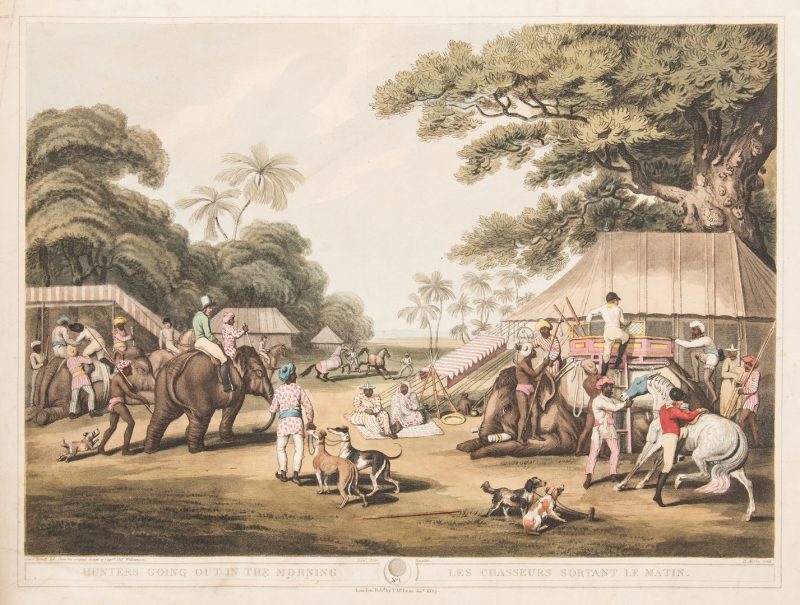 |
Oriental Field Sports of the East, T. Williamson, 1819 |  Oriental Field Sports of the East; Being a Complete, Detailed, and Accurate Description of the Wild Sports of the East, Second Edition, taken from the manuscripts and designs by Captain Thomas Williamson, drawings by Samuel Howitt, 1819. Printed by B. R. Howlett for Thomas McClean, London. Oblong folio, 145 marble edged pages with index, 40 hand colored aquatint plates after Samuel Howitt (from sketches by Williamson) by H. Merke, J. Hamble, and Vivares, hand painted half title page, rebound in three-quarter black pebbled leather with green pebbled leather sides, gilt lettering to spine, five raised hubs, marbled end papers. Illegible 1892 Calcutta inscription to interior. 17 1/4" H x 22 5/8" W x 1 3/4" D. Early 19th century. Provenance: a Middle Tennessee estate, by descent from Thomas G.B. Wheelock. Note: Thomas G.B. Wheelock was known as an astute collector of African Art and co-author of the book "Land of the Flying Masks: Art & Culture in Burkina Faso" He also inherited a sizeable collection of Asian, British, and military related antiques from his grandparents, Gilded Age tycoon George Briggs Buchanan of New York, and William and Margaret Wheelock, who owned a Scottish manor home known as Bunker Hill. (Margaret Carmichael Wheelock was also a founding partner of the fashion firm Farquharson & Wheelock in New York). See other related lots in this auction, including lot 66, a tray with Bengal Staff Corps inscription. CONDITION: Covers in worn condition with loss to leather, cracks, largest 3 1/2" to spine, corners bumped. Pages with toning/toning impression, acid burn, foxing spots, creases, tears, pencil inscriptions, etc. to be expected from age. Plates are collated. Plate I laid down onto page. [See more photos →] |
$7,680.00 |
 |
Rare A.R. Gurrey Idyls of Hawaii Photograph Book c.1910-1915 |  IDYLS OF HAWAII, photographs and contents copyrighted by Alfred Richard Gurrey, Jr., Honolulu, T. H., circa 1910-15. Softcover, 12 leaves of taupe card stock paper with 11 mounted gelatin-silver photographs of scenic images of Hawaii with English text poems, stab-sewn into taupe card stock paper wrappers with printed light grey title lettering to front cover. 10" H x 7 3/4" W x 1/4" D. Note: this exceptionally rare book was self-published by Gurrey around the same time as his better-known, but only slightly less scarce book, "Surf Riders of Hawaii" (a copy of which is also being sold in this auction, lot #700). This book, by one of Hawaii's most important photographers, contains 2 photos of an outrigger – possibly the Gurrey family canoe "Kamaaina" that was donated to the Outrigger Canoe Club as noted in The Hawaiian Star Newspaper, Dec. 8,1908. The original negatives for the photographs in Gurrey's books were likely destroyed in a flood or fire, both of which affected his home in the 1920s. This is the first time, to our knowledge, that any copy of IDYLS OF HAWAII has ever been offered at auction. PROVENANCE: Acquired from the estate of Carol Illner of Ohio, who acquired it in a collection of books from a direct descendant of Arthur Douglas Baldwin, son of Maui entrepreneur Henry Perrine Baldwin (see lots 700-704 from this collection, also in this auction). CONDITION: Covers with light toning, creases to spine and corners, general handling wear. Left and right edges of covers and pages with slight upward bend. Pages with light toning, few minute scattered foxing spots to some pages, lower right, does not affect photographs. All photographs are present. Cord to spine is intact. [See more photos →] |
$7,680.00 |
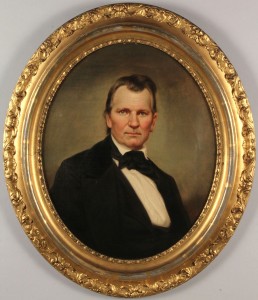 |
Portrait of CSA Gen. Daniel Smith Donelson by George Dury |  Portrait of Daniel Smith Donelson (1801-1863), oil on canvas in original giltwood frame, signed lower right and on back G. Dury (George Dury, Germany/Tennessee, 1817-1894). Daniel Smith Donelson, nephew of President Andrew Jackson, wasone of three sons born to Samuel and Mary Donelson of Sumner County, Tennessee (one of his brothers was Andrew Jackson Donelson). A graduate of West Point (1825), he had a distinguished military career before serving in the Tennessee House ofRepresentatives from 1841 until 1843 and again from 1855 until 1861. He was speaker of the house when the Civil War started. When Tennessee seceded, he returned to the military as adjutant general of the Provisional Army of Tennessee. Toprotect the Cumberland River he selected the sites for Forts Henry and Fort Donelson; the latter was named in his honor. Donelson fought in several battles, including the Battle of Murfreesboro, where he was part of the charge that broke theright wing of the Federal army. In January 1863, Donelson was given command of the Department of East Tennessee. He remained in command of the department until his death on April 17 1863 near Knoxville at Montvale Springs, TN. Five days [See more photos →] |
$7,590.00 |
 |
Cormac McCarthy, Suttree, 1st Edition, Signed |  SUTTREE by Cormac McCarthy, Random House, New York, 1979. First Edition, First Printing. Presentation copy, warmly inscribed on the ffep (front free end paper) to McCarthy's long-time friends, "For John & Lanelle / With lots of love / Cormac". G/G, Good book in Good Dust Jacket. Stated First Edition on copyright page with correct Random House number line terminating in a "2". Octavo, original boards, off-white & black cloth spine with gilt lettering. Original unclipped price of $12.95. 8 5/8" H x 6" W x 1 5/8" D. PROVENANCE: Collection of the original giftee, East Tennessee. CONDITION: G/G, book slightly loose, fixing to top and fore edges, slight soiling to covers; DJ (dust jacket) is intact with chipping to top of spine, 1/4" tears top corners, general rubbing; protected in archival cover. [See more photos →] |
$7,320.00 |
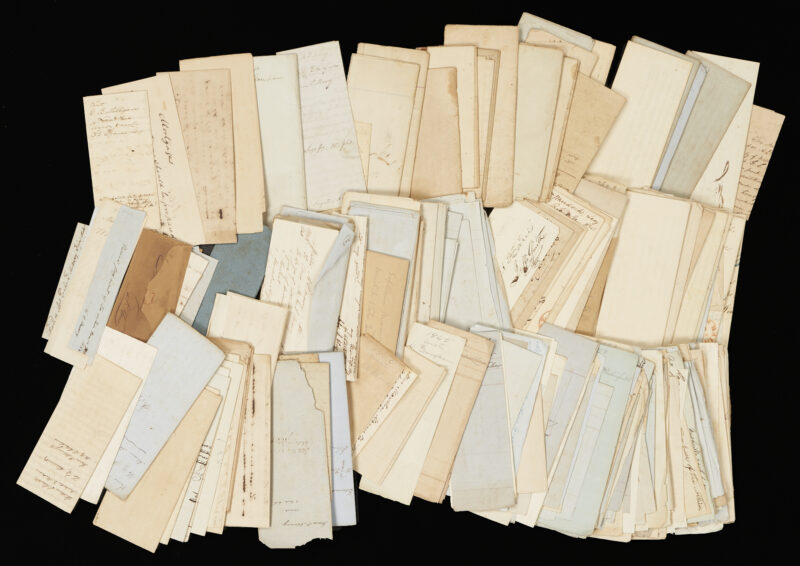 |
Abram Maury and Carey Harris Franklin TN Family Archive plus Mississippi Cotton Co. |  Archive of approximately 150 items related to the Abram Maury and Carey Harris families of Middle Tennessee. Abram Poindexter Maury Sr. (1766-1825) was a Revolutionary War major from Virginia who settled in Middle Tennessee in 1797. In 1799 he donated the land for what would become Franklin, the seat of Williamson County and, as a surveyor, laid out the plan for the town. His son in law, Carey Allen Harris Sr. (1806-1842) and son, Abram Poindexter Maury, Jr. (1801-1848), founded the Nashville Republican Newspaper in 1824. The younger Maury was a Tennessee state representative, senator, and later U.S. Congressman. Harris went on to prominence in Andrew Jackson's circle and was appointed Commissioner of Indian Affairs in 1836. He was involved in the forcible removal of Native Americans from the Southeast, and was forced to resign and return to Tennessee after evidence of his role in a scheme to speculate in Indian allotments came to light in 1838. He died a few years later at the age of 36. (Note: although his political career ended in disgrace, Harris is also remembered for his role in printing "The Western Harmony" in 1824, which marked the beginning of music publishing in Nashville). This archive includes an 1805 land document in which John Purviance (of Bourbon Co, KY) appoints friends John Mitchell and Abram Maury his attorneys to dispose of his interest in 12 lots in the town of Franklin "which all adjoin and compose a square at the east end of in the town"; an 1853 copy/transcript of a land indenture between Nashville founder James Robertson and Franklin founder Abram Maury (1766-1825) for 120 acres in Williamson County plus at least 2 dozen other land indentures and early copies of land indentures; 1810 will of Abram P. Maury granting his wife Martha his "original tract of land of about 210 acres" and "her choice third of all my Negroes" and requesting that his "stock furniture and utensils of every kind may be kept together" (note: this will was eventually superseded by an updated will, not included); an estate document regarding the bequest of a "negro boy named Godfrey commonly known by the name of Gent" by Mary Eliza Tennessee Maury to James P. Maury in 1852; an unsigned 1859 document (draft) appointing John A. Linton of Washington DC power of attorney on behalf of Edward Breathitt, William H. Carroll and his wife Eliza of Franklin TN, and John H. Handy, and Edward and Maria Crutcher of Memphis, in the settlement of the estate of John H. Eaton (1790-1856), the controversial Andrew Jackson cabinet member and Secretary of War; a few personal letters to and from Sarah (Sally) Claiborne Maury Reid regarding her son William Steptoe Reid; Reid family 1853 document regarding an estate transfer of "slave property"; a petition to an Arkansas judge to reclaim $4,000 from a business deal, signed John C. McLemore; and more than 100 receipts/financial records including tax and insurance payments and for household goods including an 1850 "House and Family Expenses" record (the largest expense listed was "clothing for negroes" at $54.09). The receipts pertain to Carey A. Harris Sr. and Jr., Abram Poindexter Maury Sr. and Jr., James P. Maury; James and Martha Harris. Land indentures mention Robert White, G. White, John Porter, Abel Garrett, Thomas Craighead, and others, in addition to various members of the Maury family. Signatures include Carey A. Harris Sr. and Jr., Abram Poindexter Maury Sr. and Jr, and other Maury family members. This archive also includes approximately 2 dozen documents relating to the establishment of the ill-fated Mississippi Cotton Company. The company was incorporated in Natchez and even hired a Scottish Textile expert to build the mill, but the 1837 Financial Crash forced the company to abandon its plans before construction could begin. Includes two printed pamphlets: AN ACT TO CREATE AND ESTABLISH THE MISSISSIPPI COTTON COMPANY (Mississippi State Legislature, 1831); handwritten draft of the company Bylaws (tear to edge); and undated handwritten draft of a resolution to begin operations, including a proposal that ââ¬Åmembers pay up the amount of their stock by giving notes secured by mortgages on plantations and negroes." NOTE: SEE RELATED LOT #511 and #577 IN THIS AUCTION. PROVENANCE: By descent in the families of Abram P. Maury and Carey A. Harris. CONDITION: 2" area of loss to Abram Maury's will, both this document and the 1805 Purviance – Maury indenture are fragile with fold line separations. Mary Maury/"Godfrey" estate document has significant losses at edges, up to 2". Other items in the archive with expected toning and light discoloration, scattered losses and stains, some faded sections, overall good condition. [See more photos →] |
$7,320.00 |
 |
Portrait of a Spanish Colonial Officer |  Late 17th/early 18th century oil on canvas portrait of a Spanish Colonial officer, possibly a member of the viceroyalty, standing In his military dress uniform with sash belt and sword, medal with ribbon around his neck. Subject holds a letter in one hand reading: “Prospecto para mejorar de sueldos a los Individuos de la real casa de Moneda de Santafe” – prospect to improve the salaries of the individuals of the royal mint of Santafe (Bogata, Columbia) and a cane in the other. Coat of Arms upper left corner reading “Armas de los Henriquez de Guzman”. Unsigned. Housed in a later gilt carved Baroque style frame with corner and side ornaments; Wunderly Bros., Pittsburgh framing label en verso. Sight – 34″ H x 26 3/4″ W. Framed – 45 1/2″ H x 38″ W. Provenance: a Nashville, Tennessee estate. CONDITION: Relined, with overall fine cracquelure. Area of paint loss to lowermost edge of canvas near frame edge near top of subject’s right leg. Triangular shaped area of inpainting/overpainting visible under UV light between crest and subject’s head. Scattered light grime and tiny accretions. A few scattered losses to gilding on frame. [See more photos →] |
$7,200.00 |
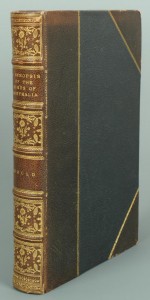 |
Gould’s Synopsis of The Birds of Australia |  A Synopsis of The Birds of Australia and the Adjacent Islands by John Gould, F.L.S., published by the author, 20 Broad Street, Golden Square, London, 1837-38. 73 hand-colored lithographic plates by and after Elizabeth Gould, 8 pp. Description of New Species at end. Owner’s bookplate on end paper: George Ernest Morrison. Paper label on end paper: Angus and Robertson, Booksellers to the University, 89 Castlereagh Street, Sydney. Sheets: 10-5/8″ x 7-1/8″, Volume: super octavo. Dark green half-leather, gilt-ruled, decorative stamped binding, all edges gilt. Provenance: George Ernest Morrison (1862-1920) was a journalist, traveller and political adviser to the Chinese government. He sold his library of Western language works on China, over 20,000 volumes, maps and pamphlets in 1917 to Baron Iwasaki, then president of Japan’s Mitsubishi Corp. The collection is now held by the Tokyo Toyo Bunka Kenkyusho. (See Australian Dictionary of Biography, Australian National University). Condition: Minor scattered foxing except for plate of “Graucalus Tenuirostris”, “Graucalus Swainsonii”, “Graucalus Mentalis”. Joints and corners rubbed. [See more photos →] |
$7,192.00 |
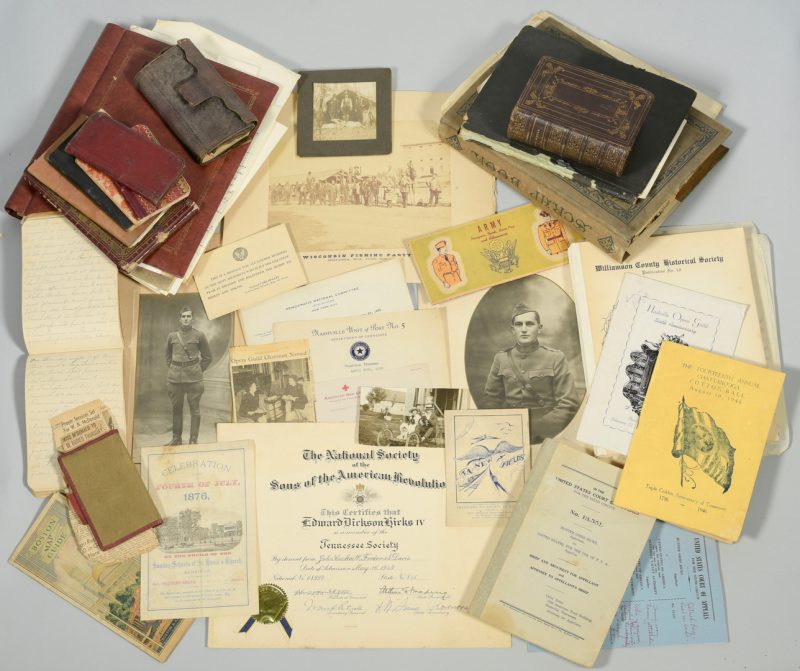 |
Hicks Family Archive, TN |  An extensive archive of material related to the family of Edward Dickson Hicks II, Edward Dickson Hicks III and Edward Dickson Hicks IV of Devon Farm, Nashville, Tennessee. The archive covers the men and their families over a time period from roughly 1850-1960, with the majority of ephemera dating from 1865, when Edward Dickson Hicks II (1831-1894) inherited the property from his aunt Fanny Harding and began raising Devon Farm cattle. The archive includes several hundred letters, many in original envelopes with postage stamps; dozens of postcards; several hundred receipts for furnishings, farm purposes, and services such as tuition of children from tutors and the Shelby Female Insititute (many on decorative letterhead of late 19th-early 20th century Nashville establishments); approximately 1 dozen land documents including deeds/indentures; broadside for the sale of Ed Hicks property Grassland, 12 miles southwest of Nashville; 50 to 100 photographs of family members, many identified verso, including an 8″ x 10″ print of Hunter Giers Hicks greeting First Lady Eleanor Roosevelt outside a train (the two ladies were said to have been friends), a photograph of Hunter Giers Hicks as a baby with her nurse Minnie, taken by her father, noted Nashville photographer Otto Giers, and scenes of cattle and farm life. 7 small notebooks/journals are present, including Ed Hicks account of his visit to the World’s Industrial and Cotton Centennial Exhibition in New Orleans in 1885 and his expenditures; 1858 savings deposit book; 1866 diary with mostly farm related entries; a circa 1868 account book; an 1849 school notebook; “Mrs. Hicks'” (probably Mary Ann White Hicks or Harriet Cockrill Hicks) 1903-1905 journal with entries, mostly personal, but including an eclipse in Africa “visible in America at daylight,”, seeing a ferris wheel, yellow fever epidemic in New Orleans, creating “anxiety throughout the South”; peace between Russia and Japan – “Roosevelt is a peace maker;” and a 1907-1909 diary likely also from Mrs. Hicks, opens with “Today President Roosevelt arrived at nine o’clock and one grand __ was given him. He spoke at the Auditorium and then went to the Hermitage to visit the tomb of Andrew Jackson.” Includes some newspaper clippings, poems and other notes in the back. Other notable items in the archive include: Holy Bible, printed London 1853 by Eyre & Spottiswoode (no family info); ephemera related to Ed Hicks II’s role as administrator for the estate of John Davis c. 1853-1854; a 1856 “Phrenological Character” report on E.D. Hicks given at Fowler and Wells Phrenological Cabinet in New York (“You have a comparatively tough and enduring constitution, but have the appearance of having lived in a bad climate or having engaged in some occupation that was too confining for health, and have thus apparently run down…” ); 1857 letter commissioning Edward Hicks as delegate to the Southern Commercial Convention in Knoxville on orders of Gov. Andrew Anderson; Appointment signed by Governor Alvin Hawkins appointing Ed Hicks Fish Commissioner for Middle Tennessee, 1862; survey map of land along the Harpeth, possibly Devon Farm; plot of a field belonging to Jas. Greer, “Surveyed by Ed Hicks May 20, 1872 His first survey for which he received $1.30”; Broadside/advertisement for the Hurricane Mills Woolen Mills in Waverly, TN dated 1868; ephemera related to Hicks’ role in the Nashville Commercial Insurance Co including an 1868 telegram: “Our store was burned last night send an agent immediately,” signed J.M. White & Co. of Dresden, TN; an 1875 booklet titled Nashville Fire Alarm Telegraph Signal Stations; Emma Hicks’ autograph book with tipped in Victorian lithographed illustrations, circa 1892, containing approximately 50 autographs of young ladies; an 1891 secretarial signed letter from Gov. John P. Buchanan to Ed Hicks expressing regret at not being able to attend a meeting of the University of Nashville board of trustees; letter from the U.S. Dept. of Agriculture commissioning Ed Hicks to collect samples of grain for the World’s Columbian Exhibition in 1893; a softcover book, “Information for Immigrants concerning Middle Tennessee and counties in that Division traversed by The Nashville, Chattanooga, and St. Louis Railway, published 1896 in Nashville and picturing “Hicks Cattle Farm, Davidson County”; wallet stamped E.D. Hicks Jr. (III) with hunting/fishing license and other various cards etc inside; newspaper obituary clippings and some family genealogy information; ephemera related to the Dobson-Hicks Seed Company, late 19th to early 20th century; 4 letters dated 1957 related to Ed Hicks service on the Nashville Metropolitan Charter Commission; and 2 personal letters from Gov. Buford Ellington including one expressing sadness at Ed Hicks’ death in 1962. CONDITION: Most items in good condition with expected toning, light handling grime, some tears to fold lines on earlier paper items and corner chips on photographs. A few documents exhibit chew losses. Several 19th century envelopes are worn with holes. Due to the large number of items in this archive, a personal examination is advised if you are planning to bid. [See more photos →] |
$7,080.00 |
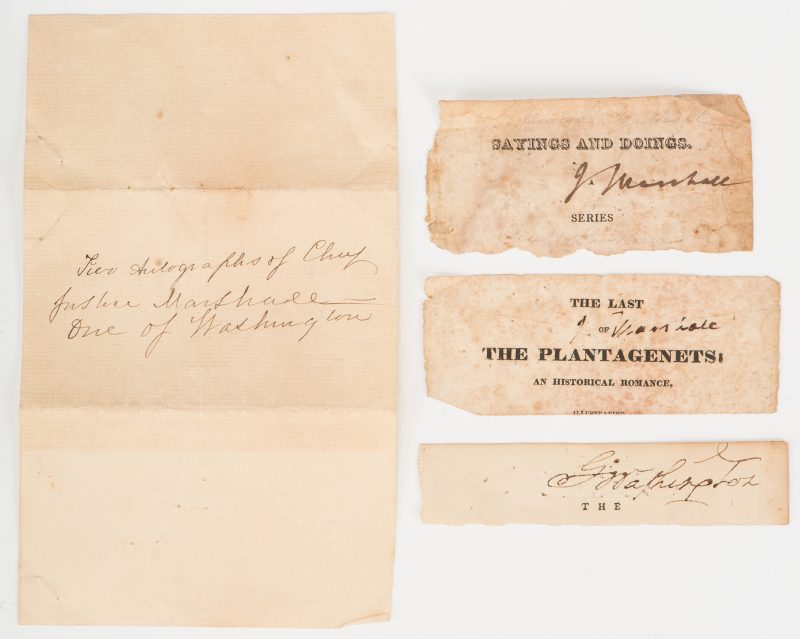 |
1 George Washington & 2 John Marshall Cut Signatures, Plus Mt. Vernon Albumen Print |  1st-3rd items: Three (3) cut book pages with signatures including one (1) George Washington and two (2) John Marshall. COAs from Stuart Lutz Historic Documents, Inc. will be provided for this lot. 1st item: George Washington (1732-1799) cut signature from the title page of an unidentified book, undated. Ink signature reads “G Washington” top right. 1 1/4″ H x 4 7/8″ W. 2nd item: John Marshall cut signature from the title page of “Sayings and Doings. A Series of Sketches from Life” by Theodore Hook, 1824. Ink signature reads “J Marshall” center right, with additional light pencil signatures by James Keith Marshall, John Marshall’s son, reading “James K. Marshall Leeds Fauquier” top and bottom center. 2 1/4″ H x 4 1/4″ W. 3rd item: John Marshall cut signature from the title page of “The Last of the Plantagenets: An Historical Romance” by William Heseltine, 1829. Ink signature reads “J Marshall” center right. 1 7/8″ H x 4 5/8″ W. All signatures accompanied by a leaf of folded laid paper identifying them as “two autographs of Chief Justice Marshall one of Washington” in 19th century script. Note: Marshallís ancestor William Marshal, 1st Earl of Pembroke (1146 or 1147-1219), also called called William the Marshal, was an important figure in the development of classic knighthood during the reigns of Plantagenet kings Henry II, Richard I, John, Henry III, and Geoffrey Plantagenet, Count of Anjou. The ìLe Mareshalsî accompanied William the Conqueror during the Norman conquest of England in 1066. (courtesy: Robert L. Hawkins, III). Note: James Keith Marshall (1800-1862) was a Virginia planter and politician. He served in the Virginia General Assembly as a delegate and as a state Senator, including after Virginia declared its secession during the American Civil War. John Marshall (1755-1835) was the Fourth Chief Justice of the United States and also served as Secretary of State under John Adams (1800-1801). 4th item: Albumen print of Mount Vernon, titled in pencil lower right and signed in pencil “Handy” possibly for Levin Corbin Handy (1855-1932), an American photographer who was related by marriage to Matthew Brady and apprenticed with him beginning at age 12. Image mounted on cardstock. Image – 7″ H x 9 1/2″ W. Cardstock – 9 3/8″ H x 12 3/8″ W. CONDITION: 1st item: Washington signature in overall good condition, slightly affected by pinprick holes. 1 1/4″ x 1/4″ area of toning, right side of paper (does not affect signature). 2nd item: John Marshall signature in overall good, strong condition, slightly affected by pinprick holes and areas of dampstaining. James K. Marshall pencil signature and inscription faint but visible. 3rd item: John Marshall signature in overall good, condition with areas of lifting to pen strokes, slightly affected by pinprick holes and foxing spots. 5/8″ x 1/4″ area of dampstaining, center right (does not affect signature). 4th item: Some grime and toning. Chipping to cardstock edges. [See more photos →] |
$7,040.00 |
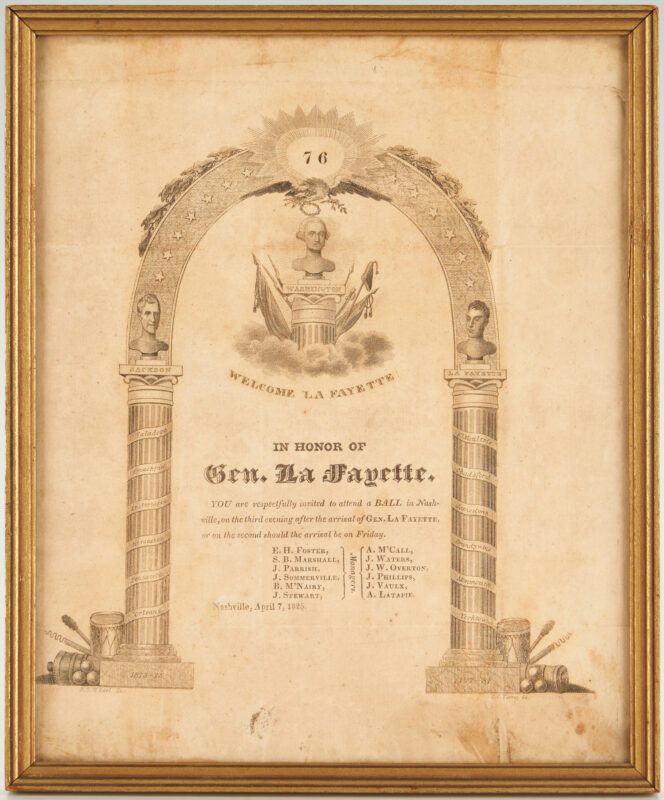 |
AJ Donelson's Invitation to Lafayette Ball in Nashville 1825, des. by Ralph Earl |  Engraved invitation to the Ball held in Nashville, Tennessee in 1825 to welcome Revolutionary War hero the Marquis de La Fayette, General Gilbert du Motier (1757-1834) on his tour of the United States. The invitation, designed by artist Ralph Eleaser Whiteside Earl (Tennessee/Connecticut/England, 1788-1838), is addressed to Andrew Jackson Donelson (1799-1871), nephew and private secretary to President Andrew Jackson. Dated April 7, 1825, the invitation includes the names of several prominent "managers" of the event, enclosed within a decorative arch, flanked by busts of then-General Jackson and La Fayette on columns emblazoned with names of Revolutionary War battles, and surmounted by a larger bust of George Washington surrounded by clouds and patriotic motifs with the words "WELCOME LA FAYETTE", top. Artist and engraver name C.C. Torrey, lower left and right below image. Label for The Veerhof Galleries, Washington, D.C., en verso of frame. Housed under double-sided glass in a giltwood frame. Sight: 7 3/8" H x 4 7/8" W. Framed: 8 1/2" H x 6" W. Note: In 1777, the then 19-year old Marquis de La Fayette left his home in France to join America's fight for independence. His assistance proved greatly consequential, and in 1824, President James Monroe asked Lafayette to revisit the United States as the "Nation's Guest". His celebratory tour was remembered as "a triumphal march to which there had never been a parallel in the history of the nation" (Wilkins Tannehill, The Port Folio, Nashville, 1848, p. 150). It included visits to more than 40 cities in 15 states, where he was greeted as a hero with parades and parties. "The Lafayette Ball", held May 5, was the social event of the year in Nashville. It was held at the Masonic Hall with three hundred guests in attendance and, according to period accounts, included a lavish dinner and dancing. After being toasted by the ladies, Lafayette is said to have toasted them in return saying "Tennessee Beauty – equal to Tennessee Valor." (Source: Ann Harwell Wells, Tennessee Historical Quarterly, Vol. 34, No. 1, 1975). The designer of this rare invitation, artist Ralph Earl, was Andrew Jackson's confidante, relative by marriage, and "court painter" during his eight years in the White House (1829-1837). In this capacity Earl produced numerous likenesses of the seventh president and his social circle. Note: This particular invitation is discussed in "Selling Andrew Jackson: Ralph E. W. Earl and the Politics of Portraiture" by Rachel Stephens, published by the University of South Carolina Press, Columbia, 2018, p. 66. PROVENANCE: By descent from the estate of Stanley Horn, Nashville, Tennessee. CONDITION: Overall toning, minute foxing spots, stains due to handling wear, creases and fold lines with very minute tears. Not examined outside of frame. [See more photos →] |
$7,040.00 |
 |
Dickens, A Christmas Carol, 1st Ed. 1843 |  A CHRISTMAS CAROL, First Edition, Second Issue, by Charles Dickens, with illustrations by John Leech, published by Chapman and Hall, London, 1843. Hardcover 12mo, 166 gilt edged pages with hand colored frontispiece and three plates, four vignettes, and one double-sided back advertisement page, title page printed in red and blue, half-title in blue, rebound by Riviere and Son, London in red morocco leather with gilt stamped covers and spine, five raised hubs, dark green paper pastedowns and endpapers, ex libris plate to interior of front cover. Original brown cloth blindstamped and gilt titled covers and spine laid down to back matter pages. 6 1/2" H x 4 3/8" W x 3/4" D. Note: This copy includes the second issue points: Roman numerals with Staves in table of contents and numbers spelled out in chapter headings. PROVENANCE: The Estate of Edith (Edie) M. Bass, Nashville, Tennessee. Most of the items from her estate in this auction were by descent from her parents, Walter Paul McBride and Claire Childs of Lake Forest, Illinois. CONDITION: Covers in overall very good condition with wear to hinges, corners slightly bumped. Pages in overall good, legible condition with toning/acid burn, scattered foxing spots, scuffs, minor pencil marks, light handling wear. Plates are collated. Some pages unevenly cut. [See more photos →] |
$7,040.00 |
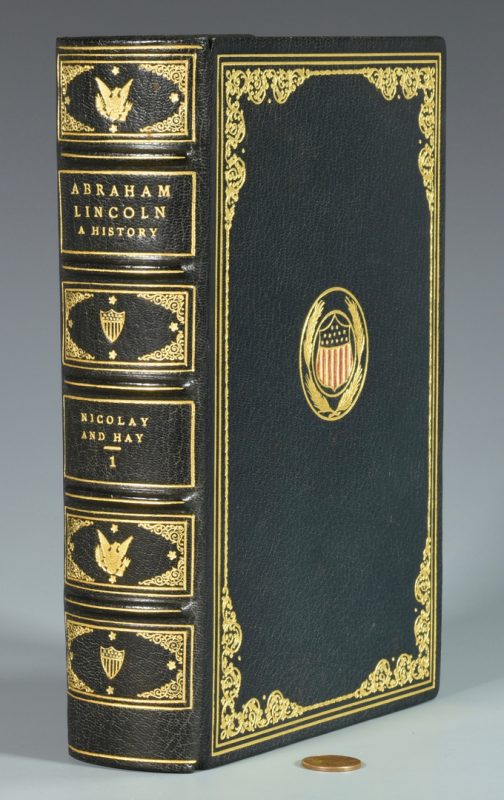 |
Abraham Lincoln Pardon, Book and Author Autographs |  President Abraham Lincoln signed pardon release order for Wilburn Bybee dated Oct. 7, 1864, partially printed on blue paper, approx. 8″ x 10″, adhered within the book “Abraham Lincoln, A History” by John G. Nicolay and John Hay (New York: The Century Company, 1890; measuring 9″ x 6 1/2″), along with unrelated letters autographed by the book’s authors. These letters, also adhered to the front leaves, include a handwritten note on Supreme Court of the United States letterhead addressed to Harry Hance of West Chester, PA and dated March 11, 1886, reading “My Dear Sir, I regret I am unable to send you an autograph of President Lincoln or to indicate where one could be obtained. Yours Truly, John G. Nicolay”; and a printed note, signed in ink, on Department of State letterhead dated April 6, 1901 and addressed to Fred M. Hopkins of New York, reading “Dear Sir: The address you speak of was published by John Lane in London. I think he also has a publishing office in New York. I am not able to say whether he has any copies of the address on hand. I regret I have none myself. Yours sincerely, John Hay.” A note fully adhered to the front fly leaf from the bookseller Harry E. Davis of Chicago explains that this book was the first of ten volumes of the original 1890 edition of the first book publication of “Abraham Lincoln: A History” by Nicolay and Hay; that the three signed inserts contain original signatures; and that the book was bound in full dark blue Morocco with emblematic tooling to the order of Randall E. Briscoe, Houston, Texas, 1952. John Nicolay (1831-1902) and John Hay (1838-1905) were Lincoln’s private secretaries and biographers. After Lincoln’s assassination, both continued in political careers. Nicolay went on to be Marshall of the U.S. Supreme Court and Hay later became the U.S. Secretary of State under William McKinley and Theodore Roosevelt. Wilburn Bybee of Barren County, Kentucky, was incarcerated for “Robbing the U.S. Mail.” His pardon case file is on record at the National Archives/Library of Congress and may be viewed online at http://lincolnpapers2.dataformat.com/images/1864/10/243400.pdf . Provenance: the estate of Capt. L. Bush Cole, Nashville, Tennessee (formerly of Texas). CONDITION: Center fold of pardon paper and left edges of Nicolay and Hay letters have been adhered with linen tape into the fly leafs of the book at its hinge and we have not attempted to remove them; signatures are in good, clear condition and unaffected by any adhesive or folds. The letters do show some light discoloration and small stains. Book exterior in overall good condition with a few scratches to the back cover and light edge toning. Silk end papers have some minor foxing and glue staining at edges. NOTE: ONLY Volume 1 is present. [See more photos →] |
$6,608.00 |